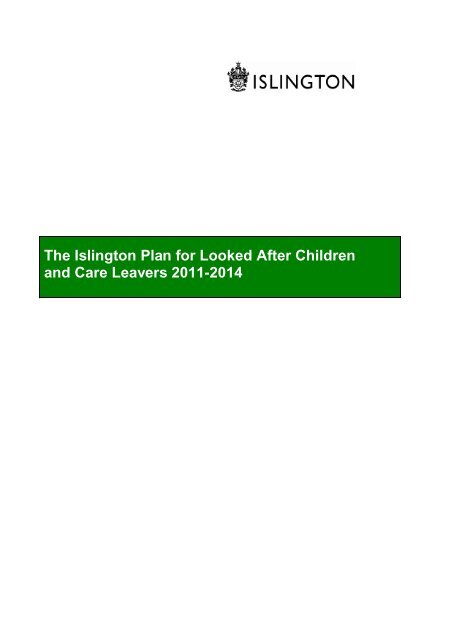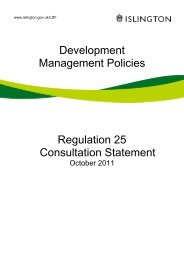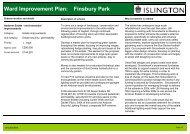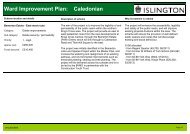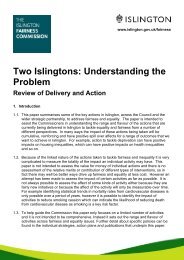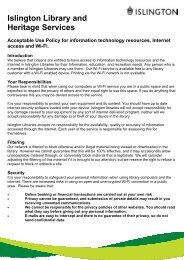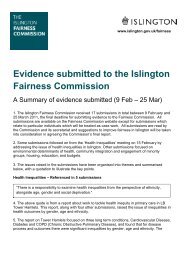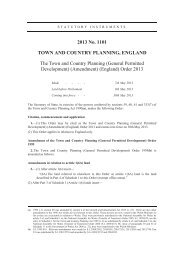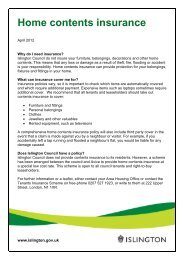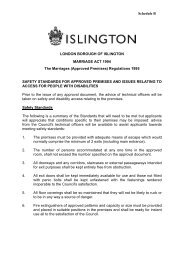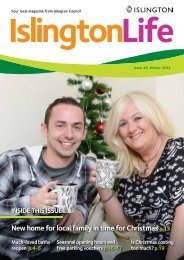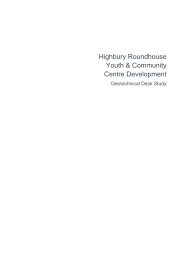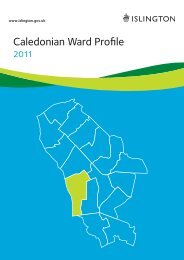The Islington Plan for Looked After Children and ... - Islington Council
The Islington Plan for Looked After Children and ... - Islington Council
The Islington Plan for Looked After Children and ... - Islington Council
Create successful ePaper yourself
Turn your PDF publications into a flip-book with our unique Google optimized e-Paper software.
<strong>The</strong> <strong>Islington</strong> <strong>Plan</strong> <strong>for</strong> <strong>Looked</strong> <strong>After</strong> <strong>Children</strong><br />
<strong>and</strong> Care Leavers 2011-2014
Section<br />
Foreword: <strong>The</strong> In Care <strong>Council</strong> <strong>and</strong> Executive Member <strong>for</strong> <strong>Children</strong> <strong>and</strong><br />
Families<br />
Pages<br />
3-4<br />
Introduction 5<br />
Achievements <strong>for</strong> 2008-2011 6-8<br />
<strong>Islington</strong>’s <strong>Children</strong> <strong>Looked</strong> <strong>After</strong> <strong>and</strong> Care Leavers 9-11<br />
Our ambition <strong>and</strong> priorities 12<br />
Priority 1: To intervene early to help children <strong>and</strong> young people achieve<br />
their full potential <strong>and</strong> to prevent children becoming looked after when it<br />
is safe to do so.<br />
Priority 2: To ensure children looked after <strong>and</strong> care leavers’ views <strong>and</strong><br />
experiences influence how we plan <strong>and</strong> deliver our services.<br />
Priority 3: To improve the health, well-being <strong>and</strong> mental health of<br />
children looked after.<br />
13-16<br />
17-20<br />
21-24<br />
Priority 4: To improve educational outcomes <strong>for</strong> children looked after. 25-29<br />
Priority 5: To ensure young people are prepared <strong>for</strong> independence <strong>and</strong><br />
successful adult lives.<br />
Priority 6: To provide sufficient, suitable <strong>and</strong> stable care placements to<br />
meet the needs of children looked after <strong>and</strong> care leavers.<br />
Priority 7: To make the best use of the <strong>Council</strong>’s resources whilst<br />
achieving value <strong>for</strong> money.<br />
30-35<br />
36-39<br />
40-42<br />
Monitoring <strong>and</strong> Quality Assurance 43-44<br />
Appendix: Pledges to <strong>Islington</strong>’s <strong>Children</strong> <strong>Looked</strong> <strong>After</strong> <strong>and</strong> Care<br />
Leavers 2011-2012<br />
45<br />
2
Foreword<br />
<strong>The</strong> In Care <strong>Council</strong><br />
As Chair <strong>and</strong> Deputy Chair of the In Care <strong>Council</strong> we were involved in getting<br />
young peoples views on this plan. <strong>The</strong> In Care <strong>Council</strong> had lots of discussions<br />
about it <strong>and</strong> ran a telephone survey to find out what other looked after children<br />
<strong>and</strong> young people thought was important to go in the plan. We sit on the<br />
Corporate Parenting Board <strong>and</strong> were able to talk to managers <strong>and</strong> councillors<br />
about it <strong>and</strong> see their commitment to the things that they have said they will do. It<br />
is great to see that young people’s views have been listened to in the plan as it is<br />
all about their lives.<br />
<strong>The</strong> other good thing is that the In Care <strong>Council</strong> will be involved in monitoring the<br />
plan to see that the actions set out in it are carried out.<br />
We hope that the plan will help make sure that our looked after children get the<br />
best care <strong>and</strong> support. <strong>The</strong>re are lots of successful people who were in care as<br />
children <strong>and</strong> with the right support from carers <strong>and</strong> social workers our <strong>Islington</strong><br />
looked after children can also achieve good things in life.<br />
Ahmed Abdul- Aziz<br />
Chair of the In Care <strong>Council</strong><br />
Efrem Semereab<br />
Deputy Chair of the In Care <strong>Council</strong><br />
3
Cllr Richard Watts Executive Member <strong>for</strong> <strong>Children</strong> <strong>and</strong><br />
Families<br />
Nothing is more important to <strong>Islington</strong> <strong>Council</strong> than how we look after the children<br />
in our care. <strong>The</strong> <strong>Council</strong>’s commitment to our corporate parenting duties shines<br />
through this revised <strong>Children</strong> <strong>Looked</strong> <strong>After</strong> <strong>Plan</strong> <strong>for</strong> 2011-2014.<br />
I am pleased that looked after children <strong>and</strong> young people have been involved in<br />
developing the plan <strong>and</strong> are in support of its aims <strong>and</strong> objectives. <strong>After</strong> all, they<br />
are the experts in the services they receive.<br />
I am also pleased that there is a clear commitment from across the range of<br />
partner organisations working with our looked after children to improve the quality<br />
of service they receive.<br />
This plan sets out both how, working together, the <strong>Council</strong> <strong>and</strong> our partners will<br />
work to improve the life chances of young people in care through ensuring safe,<br />
nurturing <strong>and</strong> stable placements leading to our young people making a<br />
successful transition to adulthood.<br />
Richard Watts<br />
Executive Member <strong>for</strong> <strong>Children</strong> <strong>and</strong> Families<br />
<strong>Islington</strong> <strong>Council</strong><br />
4
1. Introduction<br />
This is a multi agency plan that sets out the <strong>Council</strong>’s <strong>and</strong> its partners’<br />
commitment to improving the lives of <strong>and</strong> outcomes <strong>for</strong> <strong>Islington</strong>’s children looked<br />
after <strong>and</strong> care leavers. <strong>The</strong> plan will support the <strong>Children</strong> <strong>and</strong> Families Strategy<br />
2011-2015.<br />
<strong>The</strong> <strong>Children</strong> <strong>and</strong> Families Strategy sets out the <strong>Children</strong>’s Partnership’s aim to<br />
break the cycle of poverty, social exclusion <strong>and</strong> disadvantage experienced by<br />
<strong>Islington</strong> families <strong>and</strong> improve their quality of life.<br />
<strong>The</strong> ‘golden thread’ linking the strategy to this <strong>Children</strong> <strong>Looked</strong> <strong>After</strong> <strong>Plan</strong><br />
recognises the role of <strong>Children</strong>’s Social Care as a champion <strong>for</strong> the promotion of<br />
good life chances <strong>for</strong> vulnerable children. This plan will support the Strategy by<br />
ensuring that children looked after receive the quality of care necessary to<br />
achieve the best possible outcomes thereby reducing the risk of social exclusion<br />
<strong>and</strong> poverty once they leave care.<br />
This plan will help the <strong>Council</strong> to:<br />
<br />
<br />
<br />
Underst<strong>and</strong> the current <strong>and</strong> future needs of children looked after<br />
aged 0-18 <strong>and</strong> care leavers aged 18-25.<br />
Rein<strong>for</strong>ce the corporate parenting responsibility of the <strong>Council</strong> <strong>and</strong><br />
partners.<br />
Ensure that the race, gender, disability, sexuality, age, religion <strong>and</strong><br />
culture of children looked after <strong>and</strong> care leavers are considered in<br />
planning to meet their needs.<br />
This plan will be supported by <strong>Islington</strong>’s Strategy <strong>for</strong> Ensuring Sufficient<br />
Accommodation <strong>for</strong> <strong>Children</strong> <strong>Looked</strong> <strong>After</strong> <strong>and</strong> by <strong>Islington</strong>’s Early Intervention<br />
<strong>and</strong> Prevention Strategy.<br />
Partner agencies have been engaged in identifying key service challenges as<br />
well as priorities <strong>for</strong> future service delivery as set out in this plan.<br />
<strong>The</strong> plan is supported by a multi agency action plan which has been developed in<br />
order to assist the <strong>Council</strong> <strong>and</strong> the agencies responsible <strong>for</strong> corporate parenting<br />
to achieve the desired goals <strong>and</strong> impact.<br />
5
2. Achievements <strong>for</strong> 2008-2011<br />
Outcomes <strong>for</strong> children looked after<br />
<strong>The</strong> <strong>Looked</strong> <strong>After</strong> <strong>Children</strong> <strong>and</strong> Young People’s <strong>Plan</strong> 2008-2011 identified a<br />
number of targets <strong>and</strong> actions. <strong>The</strong>re have been significant achievements in<br />
relation to the plan that include:<br />
<br />
<br />
<br />
<br />
<br />
<br />
<br />
<br />
Improvement in the stability of placements.<br />
An increase in the proportion of children with permanent placements through<br />
Special Guardianship Orders or Adoption.<br />
A higher proportion of children <strong>and</strong> young people now looked after in family<br />
settings rather than in residential care.<br />
More children with up to date immunisations, health assessments <strong>and</strong> dental<br />
checks.<br />
Improvements in school attendance <strong>and</strong> a reduction in permanent exclusions.<br />
Improvements in attainment at Key Stage 2 (children aged 7 to 11 years).<br />
An increase in the proportion of care leavers in suitable accommodation.<br />
An increase in the proportion of care leavers in education, training<br />
employment <strong>and</strong> at university.<br />
Local St<strong>and</strong>ards <strong>and</strong> targets<br />
In terms of local st<strong>and</strong>ards <strong>and</strong> targets <strong>Islington</strong> is doing well in the following<br />
areas:<br />
Reducing the number of children looked after as a result of effective early<br />
intervention <strong>and</strong> permanency planning. <strong>Islington</strong> had a 32% reduction since<br />
2004 <strong>and</strong> 4.5% reduction since 2009. 1<br />
Placing children with relatives <strong>and</strong> friends (an increase of 10.5%).<br />
<strong>The</strong> availability of work placements <strong>and</strong> work experience opportunities <strong>for</strong><br />
care leavers.<br />
<strong>The</strong> number of care leavers at university (72 young people).<br />
<strong>The</strong> proportion of looked after children placed locally with <strong>Islington</strong> foster<br />
carers (48%).<br />
14 Special Guardianship Order made this year.<br />
1 This does not include emergency accommodation <strong>for</strong> 16 <strong>and</strong> 17 year olds presenting as<br />
homeless which has increased since the Southwark Ruling.<br />
6
Being Healthy<br />
<br />
98.2 % of children looked after had completed Health Assessments, 2 nd<br />
highest in London (London average 86%).<br />
89% of children are fully immunized (London Average 82%).<br />
<br />
<br />
95% of Strengths <strong>and</strong> Difficulties questionnaires, used to identify particular<br />
emotional <strong>and</strong> behavioural needs, were completed (as at March 2011).<br />
<strong>The</strong> number of children receiving an intervention <strong>for</strong> their substance misuse<br />
problems increased from 50% last year to 92.9%.<br />
Staying Safe<br />
93% of the looked after population have good school attendance. Only 7%<br />
(11 children) missed 25 days or more of education in the last academic year.<br />
Enjoy <strong>and</strong> Achieve<br />
<br />
<br />
<br />
<strong>The</strong>re has been consistent improvement in the educational attainment of<br />
looked after children at Key stages 2 <strong>and</strong> 4. Young people at Key Stage 2<br />
have exceeded the national children looked after average <strong>for</strong> all subjects<br />
(based on 2008/09 figures).<br />
<strong>The</strong> number of children in year 11 during 10/11 in full time education or<br />
training has gone up from 77.1% to 96.6 % (as at 31st March 2011)<br />
<strong>The</strong>re has been a 26% increase in the number of pupils at the end of Key<br />
Stage 3 who achieved a level 5.<br />
56% of the looked after population have achieved level 4 in English <strong>and</strong> 61%<br />
have achieved level 4 in Maths at Key stage 2.<br />
<br />
<br />
<br />
<br />
Young people in year 11 received their best ever result <strong>for</strong> 1 or more A* - G<br />
grade GCSEs, with 93% of the cohort achieving to this st<strong>and</strong>ard.<br />
This year also shows the best ever results of pupils achieving at least 5 A* - G<br />
grade GCSEs at the end of Key Stage 4.<br />
<strong>The</strong> percentage of young people leaving care aged 16 or over with 1 GCSE<br />
grade A-G has increased from 49.1% last year to 55.8% this year.<br />
School attendance has improved by 13% over five years, which is higher than<br />
our statistical neighbours <strong>and</strong> better than other inner London <strong>Council</strong>s.<br />
<strong>Children</strong> <strong>Looked</strong> <strong>After</strong> are engaging in positive activities: <strong>The</strong>y used 1,172<br />
free gym places in the first three months of this year.<br />
7
Positive Contribution<br />
<br />
<br />
93% of children over 4 years old communicated their views as part of their<br />
child care review. <strong>The</strong> target indicator was 98%. (7% chose not to contribute).<br />
195 children <strong>and</strong> young people gave feedback to the <strong>Council</strong> <strong>and</strong> partners<br />
through the <strong>Children</strong>’s Active Involvement Service in the last year on areas<br />
such as the Pledges, the return of Leaving Care Services to the <strong>Council</strong>, the<br />
proposed move to a new <strong>Council</strong> building in 2012, the quality of services to<br />
children looked after <strong>and</strong> care leavers, relationships with social workers <strong>and</strong><br />
foster carers, housing <strong>and</strong> accommodation <strong>for</strong> care leavers, savings <strong>and</strong><br />
pocket money <strong>and</strong> safeguarding.<br />
Economic Well Being<br />
<br />
<br />
68.9 % of <strong>Islington</strong> care leavers aged 19 were in employment, education or<br />
training. This is higher than national <strong>and</strong> statistical neighbour averages <strong>and</strong> is<br />
an improvement on the previous year.<br />
<strong>The</strong> proportion of care leavers aged 19 living in suitable accommodation has<br />
increased between 2007 <strong>and</strong> 2010 from 83.6% to 93.3%.<br />
<strong>The</strong> outcomes demonstrate a trend of continuous improvement over recent<br />
years. Most <strong>for</strong>mal per<strong>for</strong>mance indicators show per<strong>for</strong>mance within the higher<br />
b<strong>and</strong>s <strong>and</strong> greater in comparison with other authorities.<br />
8
3. <strong>Islington</strong>’s <strong>Children</strong> <strong>Looked</strong> <strong>After</strong> <strong>and</strong><br />
Care Leavers<br />
<strong>Islington</strong>’s vulnerable children<br />
<strong>The</strong> total resident child population of <strong>Islington</strong> is approximately 40,500, which is<br />
about 20% of the total population. This is a slightly lower proportion than the rest<br />
of Engl<strong>and</strong>. <strong>The</strong> overall number of vulnerable children in any of these groups was<br />
1,718 in 2009/10 of whom 1,262 were <strong>Children</strong> in Need, 324 were <strong>Looked</strong> <strong>After</strong><br />
<strong>Children</strong> <strong>and</strong> 132 children were subject to a Child Protection <strong>Plan</strong>.<br />
<strong>Islington</strong>’s <strong>Children</strong> looked after <strong>and</strong> care leavers<br />
<strong>Children</strong> looked after are made up of several distinct groups, although they have<br />
overlapping as well as specific needs. <strong>The</strong>y include:<br />
- Babies <strong>and</strong> young children (particularly those 0-4 years of age)<br />
- Older children becoming looked after as adolescents<br />
- Disabled <strong>Children</strong><br />
- Young people who are parents<br />
- Young people preparing to leave care<br />
- Young people seeking asylum<br />
<br />
<br />
<br />
<br />
<strong>Children</strong> looked after in <strong>Islington</strong> are a diverse group<br />
Forty per cent of children coming into care are white. Black <strong>and</strong> dual heritage<br />
children are overrepresented in comparison to the local population. Black<br />
Somali children are underrepresented. Thirty two of <strong>Islington</strong>’s looked after<br />
children were unaccompanied asylum seeking children. Of these half are of<br />
Black African descent. Numbers of male <strong>and</strong> female children <strong>and</strong> young<br />
people coming into care are similar.<br />
One in ten of <strong>Islington</strong>’s children looked after has a recorded<br />
disability<br />
Eight children have more than one disability. It should be noted that record<br />
keeping in relation to children’s disability could be improved <strong>and</strong> thus the<br />
actual number of children looked after with disabilities may be higher.<br />
Some children looked after are also parents<br />
Between April 2009 <strong>and</strong> March 2011, 5 looked after young people aged 16 or<br />
17 were also parents.<br />
<strong>The</strong>re are a total of 302 care leavers in <strong>Islington</strong> supported by<br />
Independent Futures Leaving Care Service<br />
197 are aged between 18 <strong>and</strong> 21 years, <strong>and</strong> a further 105 are aged over 21.<br />
9
Seventeen looked after young people have severe <strong>and</strong><br />
complex disabilities (As at September 2010)<br />
A small number of these young people who have been looked after on a<br />
permanent basis leave care each year. Young people who require ongoing<br />
statutory support are transferred at 14 years to a specialist Transitions Team<br />
to enable a smooth transition to Adults’ Social Care services. <strong>The</strong> Transitions<br />
Team can work with young people up to 25 years if required. A 16+ Panel<br />
meets regularly to plan transition <strong>for</strong> young people who do not qualify <strong>for</strong><br />
statutory support from Adults’ Social Care. <strong>The</strong>se tend to be young people<br />
with autism who do not have associated learning or physical disabilities.<br />
Over sixty per cent of the children who came into <strong>Islington</strong>’s<br />
care in the last two years were under eleven years<br />
<strong>The</strong> number of very young children coming into care has been stable from<br />
year to year over the last six years (although there is some variation within<br />
each year). <strong>The</strong>se children tend to move from foster care into a permanent<br />
family arrangement, i.e. return home, special guardianship or adoption.<br />
Recently more sixteen <strong>and</strong> seventeen year olds are coming<br />
into care<br />
<strong>The</strong>re were 63 young people placed in temporary accommodation because<br />
they presented as homeless at age sixteen or seventeen years old. Of these,<br />
25 young people became looked after. <strong>The</strong>re<strong>for</strong>e, overall numbers of children<br />
looked after have increased. This is due to changes in statutory requirements<br />
in relation to youth homelessness.<br />
Two thirds of children who come into care do so due to abuse<br />
<strong>and</strong> neglect<br />
<strong>The</strong>re is little variation in terms of their gender or age. <strong>Children</strong> of all ages<br />
tend to become looked after due to abuse <strong>and</strong> neglect. <strong>Children</strong> over the age<br />
of eleven tend to have higher levels of need, e.g. involvement in crime <strong>and</strong> on<br />
rem<strong>and</strong> to the local authority, emotional <strong>and</strong> behavioural difficulties,<br />
substance misuse, involvement in anti social behaviour or gang activity, they<br />
may be pregnant, beyond parental control <strong>and</strong>/or at risk of homelessness.<br />
43 separate rem<strong>and</strong>s were made by the Courts in 2009/10 in<br />
relation to 36 young people<br />
Of these, 35 were rem<strong>and</strong>ed into custody, 4 were court ordered secure<br />
rem<strong>and</strong>s, <strong>and</strong> 4 were rem<strong>and</strong>ed to local authority accommodation.<br />
Two thirds of children coming into care will leave within a<br />
year. Twenty five per cent leave within four months<br />
A third remain in care <strong>for</strong> three or more years or until they are eighteen with<br />
older children more likely to stay in care <strong>for</strong> more than a year. When children<br />
become looked after between the ages of eight to twelve, they are more likely<br />
to remain in care.<br />
10
<strong>The</strong> total number of children looked after has decreased by an<br />
average of 5% per year over the last 6 years<br />
This is largely due to better community based family support services. It is<br />
estimated that the children looked after population will remain stable over the<br />
next five years (assuming no major local or national policy changes). <strong>The</strong><br />
number of disabled children <strong>and</strong> young people looked after has decreased<br />
since 2004. <strong>The</strong> projection excludes young people presenting as homeless at<br />
sixteen or seventeen years of age.<br />
<strong>The</strong>re has been a rise of 8% in activity levels (i.e. the numbers<br />
of bed nights that children <strong>and</strong> young people spend in their<br />
placements) from 10/11 <strong>and</strong> projected <strong>for</strong> 11/12<br />
Although the numbers of children looked after have decreased over the past<br />
six years <strong>and</strong> then stabilized, activity levels appear to be rising.<br />
<strong>Islington</strong> has a disproportionate number of children looked<br />
after compared to our statistical neighbours<br />
Although <strong>Islington</strong>’s number of children looked after per 10,000 population<br />
has decreased significantly in the last five years from 147.2 to 94, the<br />
proportion of children looked after is still relatively high.<br />
11
4. Our Ambition <strong>and</strong> Priorities<br />
Our ambition <strong>for</strong> children looked after <strong>and</strong> care leavers is that they experience<br />
the lives that we would want <strong>for</strong> our own children. Between 2011 <strong>and</strong> 2014, we<br />
will continue to work towards achieving this ambition through the delivery of one<br />
strategic objective that is to be a good <strong>and</strong> effective corporate parent.<br />
Being a good corporate parent requires us to achieve the<br />
following strategic priorities:<br />
Priority 1:<br />
Priority 2:<br />
Priority 3:<br />
Priority 4:<br />
Priority 5:<br />
To intervene early to help children <strong>and</strong> young people achieve their<br />
full potential <strong>and</strong> to prevent children becoming looked after when it<br />
is safe to do so.<br />
To ensure children looked after <strong>and</strong> care leavers’ views <strong>and</strong><br />
experiences influence how we plan <strong>and</strong> deliver our services.<br />
To improve the health, well-being <strong>and</strong> mental health of children<br />
looked after.<br />
To improve educational outcomes <strong>for</strong> children looked after.<br />
To ensure young people are prepared <strong>for</strong> independence <strong>and</strong><br />
successful adult lives.<br />
In each of these priority areas, our aim is to narrow the gap in outcomes between<br />
children looked after <strong>and</strong> their non-looked after peers, whilst ensuring that the<br />
principles of fairness <strong>and</strong> choice underpin our actions.<br />
To achieve these priorities, we must ensure that corporate parents, elected<br />
members <strong>and</strong> senior officials effectively champion <strong>and</strong> meet the needs of<br />
children looked after <strong>and</strong> care leavers. We must also ensure that those who have<br />
responsibilities <strong>for</strong> corporate parenting: the Executive Member <strong>for</strong> <strong>Children</strong> <strong>and</strong><br />
Families, the Corporate Director <strong>for</strong> <strong>Children</strong> Services, multi agency practitioners<br />
<strong>and</strong> agencies working directly with children looked after do the same.<br />
Being an effective corporate parent requires us to achieve<br />
the following strategic priorities.<br />
Priority 6:<br />
Priority 7:<br />
To provide sufficient, suitable <strong>and</strong> stable care placements to meet<br />
the needs of children looked after <strong>and</strong> care leavers.<br />
To make the best use of the <strong>Council</strong>’s resources whilst achieving<br />
value <strong>for</strong> money.<br />
12
5. Our Priorities<br />
Priority 1:<br />
To intervene early to help children <strong>and</strong><br />
young people achieve their full potential<br />
<strong>and</strong> to prevent children becoming looked<br />
after when it is safe to do so<br />
5.1.1 <strong>The</strong> current position<br />
a. <strong>Islington</strong> <strong>Council</strong> believes that children should be supported in their<br />
families wherever possible <strong>and</strong> that families should be given extra support<br />
to keep them together.<br />
b. Building on the views of children <strong>and</strong> young people expressed in the last<br />
plan, the <strong>Council</strong> has continued to develop effective multi-agency early<br />
intervention <strong>and</strong> prevention services to help more children to stay with<br />
their families.<br />
c. <strong>Islington</strong>’s aim is to find families in difficulty early <strong>and</strong> help them to address<br />
their problems. Research has shown that getting involved early to<br />
encourage social <strong>and</strong> emotional development can significantly improve<br />
mental <strong>and</strong> physical health, educational attainment <strong>and</strong> employment<br />
opportunities. Early Intervention can also help to prevent criminal<br />
behaviour (especially violent behaviour), drug <strong>and</strong> alcohol misuse,<br />
teenage pregnancy <strong>and</strong> homelessness. Conversely, waiting <strong>for</strong> problems<br />
to take root <strong>and</strong> reacting late costs the tax payers billions of pounds.<br />
d. Since the last plan, <strong>Islington</strong> has piloted a number of innovative family<br />
support initiatives, which have received national recognition <strong>for</strong> their<br />
approaches <strong>and</strong> outcomes. <strong>The</strong> key principle of ‘think family’ has been<br />
adopted to encourage all agencies working with families to take<br />
responsibility <strong>for</strong> thinking about the needs of all family members rather<br />
than just those of the particular adult or child referred. <strong>The</strong> Integrated<br />
Disabled <strong>Children</strong>’s Service continues to improve the multi-agency<br />
partnership of early intervention, support <strong>and</strong> short break services <strong>for</strong><br />
disabled children <strong>and</strong> their families.<br />
e. <strong>The</strong> <strong>Council</strong> is committed to an evidence-based approach to family<br />
support <strong>and</strong> has achieved multi-agency agreement to provide <strong>and</strong><br />
evaluate a range of evidence-based parenting programmes at universal,<br />
targeted <strong>and</strong> specialist levels of need.<br />
13
5.1.2 Summary of outcomes<br />
a. Between 2009/10 <strong>and</strong> 2010/11, there was an 8% reduction in the number<br />
of initial assessments carried out by <strong>Children</strong>’s Social Care. This<br />
suggests that families are more often having their needs assessed <strong>and</strong><br />
met by a professional in the community, e.g. learning mentor, family<br />
support worker, health visitor through the Common Assessment<br />
Framework (CAF).<br />
b. <strong>The</strong> number of children becoming looked after has steadily decreased<br />
since 2004 although the rate of decrease has slowed down in recent<br />
years. <strong>The</strong> annual figures since the last plan are 290 (2008/9, 272<br />
(2009/10), 274 (2010/11). 2<br />
c. <strong>The</strong> number of children coming into care aged eleven to fourteen years<br />
has decreased since the Adolescent Multi Agency Support Service<br />
(AMASS) was established in 2006 to provide intensive support to support<br />
the parenting of adolescents.<br />
d. Changes in statutory guidance relating to homeless young people aged 16<br />
<strong>and</strong> 17 years have increased the numbers of 16 <strong>and</strong> 17 year olds<br />
becoming looked after.<br />
5.1.3 Challenges<br />
a. Successful pilots of the ‘think family’ <strong>and</strong> early intervention multi-agency<br />
approach have been implemented to support families with multiple needs<br />
over the last few years. <strong>The</strong>se included the Think Family Pathfinder <strong>for</strong><br />
families affected by parental mental ill health <strong>and</strong> the Packington Families<br />
Project <strong>for</strong> families living in an area of particular deprivation <strong>and</strong> disruption<br />
due to the rebuilding of their estate. <strong>The</strong> challenge is to mainstream the<br />
‘think family’ <strong>and</strong> early intervention approach across all of <strong>Islington</strong>’s family<br />
support services.<br />
b. <strong>The</strong> implementation of the Common Assessment Framework has been<br />
slow in the borough <strong>and</strong> families are still asked to repeat their stories<br />
many times to different professionals.<br />
c. <strong>The</strong>re is a need to make sure that we can deliver effective early<br />
intervention <strong>and</strong> family support services to families experiencing greater<br />
stress due to the recession whilst operating in a challenging financial<br />
context.<br />
2 <strong>The</strong>se figures exclude asylum seeking children <strong>and</strong> young people <strong>and</strong> young people presenting<br />
as homeless aged 16 <strong>and</strong> 17 years.<br />
14
d. <strong>The</strong> promotion of evidence-based approaches to delivering parenting <strong>and</strong><br />
family support requires strategic support at a senior level <strong>and</strong> careful coordination<br />
<strong>and</strong> implementation at operational management level if it is to<br />
be firmly established in the borough.<br />
5.1.4 Priorities <strong>for</strong> 2011-2014<br />
a. Trans<strong>for</strong>m early intervention <strong>and</strong> prevention support <strong>for</strong> vulnerable<br />
children <strong>and</strong> families.<br />
All families need support <strong>and</strong> advice at some stage as their children grow<br />
up. For many families, this will be at times when their lives are changing:<br />
a new baby has arrived or their children are going through a change, <strong>for</strong><br />
example, from primary to secondary school or from child to adulthood. Or<br />
additional pressures are affecting their family: there is a disabled child in<br />
the family, a relationship breaks down, a family member gets sick or<br />
unexpected financial pressures mean that they fall into rent arrears or take<br />
on a debt that they cannot manage.<br />
We will develop an early intervention <strong>and</strong> prevention core offer to families<br />
to:<br />
<br />
<br />
<br />
<br />
<br />
<br />
Encourage stable families where parent(s) are able to meet children’s<br />
needs.<br />
Encourage supportive family relationships <strong>and</strong> reduce parental stress <strong>and</strong><br />
anxiety.<br />
Build families’ resilience <strong>and</strong> ability to face challenges in bringing up their<br />
children.<br />
Increase families’ networks of support within their community.<br />
Help families to get their needs met <strong>and</strong> prevent escalation of difficulties.<br />
Get parents <strong>and</strong> carers work-ready <strong>and</strong> into work.<br />
b. Co-ordinate support to families with multiple needs (Community<br />
Based Budgets).<br />
Some parents have multiple needs <strong>and</strong> are more vulnerable to life’s<br />
challenges. <strong>The</strong>y may have a baby at a young age <strong>and</strong> find it difficult to<br />
cope with the changes that brings. <strong>The</strong>y may have longer st<strong>and</strong>ing<br />
problems: a parent’s illness or disability means they struggle to cope or<br />
they experience repeated depression or a more serious mental illness.<br />
<strong>The</strong>se can be compounded by use of drugs or alcohol as a coping<br />
mechanism.<br />
As a Community Based Budget area, we will develop more intensive <strong>and</strong><br />
better co-coordinated support to improve the lives of families with multiple<br />
needs, which will include:<br />
<br />
Pooling organisational budgets to get better value <strong>for</strong> money <strong>and</strong><br />
avoid duplication.<br />
15
Redesigning systems of working with families to achieve more<br />
effective outcomes <strong>for</strong> families.<br />
c. Ensure evidence based approaches are introduced <strong>and</strong> sustained in<br />
the delivery of family support.<br />
We will implement the parenting programme framework <strong>and</strong> develop<br />
proposals <strong>for</strong> 2011-15 <strong>for</strong> commissioning <strong>and</strong> evaluating programmes.<br />
We will increase the co-ordination of family support at specialist <strong>and</strong><br />
targeted levels using evidence-based approaches.<br />
16
Priority 2:<br />
To ensure children looked after <strong>and</strong> care<br />
leavers’ views <strong>and</strong> experiences influence<br />
how we plan <strong>and</strong> deliver our services<br />
5.2.1 <strong>The</strong> current position<br />
a. As corporate parents, the <strong>Council</strong> underst<strong>and</strong>s that outcomes <strong>for</strong> children<br />
looked after <strong>and</strong> care leavers will be improved if they have opportunities to<br />
influence decision making <strong>and</strong> the support offered to them during their<br />
time in care <strong>and</strong> on the journey to independence. <strong>The</strong> structure <strong>for</strong><br />
achieving this has been in the creation of an In Care <strong>Council</strong> <strong>and</strong> an<br />
established <strong>Children</strong>’s Active Involvement Service (C.A.I.S) which offers<br />
inclusive approaches to engaging, supporting <strong>and</strong> celebrating children<br />
looked after <strong>and</strong> care leavers.<br />
b. <strong>The</strong> <strong>Children</strong> In Care <strong>Council</strong> is involved in work both locally <strong>and</strong><br />
nationally to ensure that the voices of children <strong>and</strong> young people in the<br />
care of <strong>Islington</strong> <strong>Council</strong> are heard at all levels. This has included<br />
meetings with the Minister <strong>for</strong> <strong>Children</strong> <strong>and</strong> other parliamentary officials.<br />
<strong>The</strong> Chair <strong>and</strong> Vice Chair of the In Care <strong>Council</strong> are members of the<br />
Executive Corporate Parenting Board which has given children <strong>and</strong> young<br />
people greater opportunities to influence improvements to the delivery of<br />
corporate parenting.<br />
c. <strong>The</strong> <strong>Children</strong>’s Active Involvement Service (C.A.I.S.) has provided a<br />
consistently positive route <strong>for</strong> children <strong>and</strong> young people to get involved in<br />
improving the quality of services available to them. It has also assisted the<br />
<strong>Council</strong> to underst<strong>and</strong> the experience of being looked after from children<br />
<strong>and</strong> young people’s point of view <strong>and</strong> improve or redesign services<br />
accordingly. C.A.I.S has worked closely with the In Care <strong>Council</strong> to<br />
develop yearly pledges which are monitored by children <strong>and</strong> young<br />
people. <strong>The</strong> pledges relate to the st<strong>and</strong>ards of service that children looked<br />
after <strong>and</strong> care leavers can expect to receive.<br />
d. <strong>The</strong> Quality <strong>and</strong> Safeguarding Service has updated its approach to<br />
achieve compliance with the revised care planning regulations in relation<br />
to Independent Reviewing Officers (IRO’s). IRO’s maintain their<br />
independence but are located with the <strong>Children</strong> <strong>Looked</strong> <strong>After</strong> Service to<br />
enable greater access to managers so that they can address areas of<br />
concern raised by children or call attention to avoidable delays in<br />
interventions.<br />
e. <strong>The</strong> <strong>Council</strong> has commissioned services to support children to raise<br />
issues or concerns independently. VOICE, a charity, has provided an<br />
advocacy service <strong>and</strong> the <strong>Council</strong> has commissioned independent visiting<br />
service to support children who have minimal contact with their birth<br />
families. A review of the Independent Visitors Scheme <strong>and</strong> the Advocacy<br />
Service has been undertaken <strong>and</strong> work is underway to recommission both<br />
services.<br />
17
f. An established <strong>Children</strong>’s Complaints Service supports children when they<br />
wish to raise concerns or complaints or give compliments related to the<br />
quality of care that they receive.<br />
g. <strong>The</strong> <strong>Council</strong> uses a range of methods to engage with children looked after<br />
<strong>and</strong> care leavers. <strong>The</strong> methods used to encourage active participation<br />
include:<br />
Annual surveys<br />
Involvement by children looked after in the reorganisation of services<br />
Delivering training to practitioners <strong>and</strong> partners <strong>and</strong> foster carers<br />
<br />
<br />
Taking part in the recruitment of new staff in <strong>Children</strong>’s Social Care<br />
Attending events <strong>and</strong> activities arranged by the <strong>Children</strong> In Care<br />
<strong>Council</strong> who carry out surveys at those events.<br />
5.2.2 Summary of outcomes<br />
a. 93% of children communicated their views to their reviews. (<strong>The</strong> 7% who<br />
did not communicate were young people who actively chose not to take<br />
part in their review).<br />
b. In a recent inspection, Ofsted found <strong>Islington</strong>’s Adoption Service to be<br />
'good with outst<strong>and</strong>ing features' in meeting children’s wishes <strong>and</strong> feelings,<br />
<strong>and</strong> equality <strong>and</strong> diversity. <strong>The</strong> Fostering Service was judged outst<strong>and</strong>ing<br />
in helping children to achieve well <strong>and</strong> enjoy what they do, in helping<br />
children to make a positive contribution <strong>and</strong> in promoting equality <strong>and</strong><br />
diversity.<br />
c. Young people were involved at all stages of planning <strong>for</strong> the return of<br />
leaving care services from delivery by an external provider to the <strong>Council</strong><br />
<strong>and</strong> were represented on the Stakeholder Development Board <strong>for</strong> Leaving<br />
Care. <strong>The</strong> views of children <strong>and</strong> young people were given precedence in<br />
decision making on the model <strong>for</strong> service delivery.<br />
d. Young people have been instrumental in highlighting inconsistencies in<br />
preparing them to leave care. This has resulted in the development of a<br />
Preparation <strong>for</strong> Independence Strategy <strong>and</strong> Toolkit <strong>for</strong> use by <strong>Islington</strong><br />
foster carers, partner agencies, independent agency foster carers, <strong>and</strong><br />
providers of supported accommodation.<br />
e. Young people have become more involved in taking control of the<br />
direction of their pathway plans with support from Young Person’s<br />
Advisors <strong>and</strong> Social Workers.<br />
f. <strong>The</strong> pledge audit <strong>and</strong> annual reports of the <strong>Children</strong> In Care <strong>Council</strong><br />
demonstrate a high satisfaction rate <strong>for</strong> children looked after with the care<br />
<strong>and</strong> support that they receive.<br />
g. <strong>The</strong> success of participation approaches has resulted in the <strong>Council</strong><br />
receiving a LILAC Award (Leading Improvements <strong>for</strong> <strong>Looked</strong> <strong>After</strong><br />
18
<strong>Children</strong>). Run by an independent charity, young people who have been<br />
in care are trained to assess the per<strong>for</strong>mance of agencies against the<br />
LILAC st<strong>and</strong>ards. Young people carry out assessments against stringent<br />
quality st<strong>and</strong>ards <strong>and</strong> consult with children <strong>and</strong> young people. At the time<br />
of receiving the award, the <strong>Council</strong> was only the second authority in the<br />
country to have received this award.<br />
5.2.3 Challenges<br />
a. <strong>The</strong> <strong>Council</strong>’s ability to continually see <strong>and</strong> judge the care system from the<br />
point of view of children <strong>and</strong> young people is dependent on the<br />
effectiveness of participation activity. Although participation activity is<br />
robust within <strong>Children</strong>’s Social Care, the <strong>Council</strong> faces a greater challenge<br />
in ensuring that the voices of children looked after can influence beyond<br />
the Executive Corporate Parenting Board to include others in the <strong>Council</strong><br />
with corporate parenting responsibilities.<br />
b. <strong>Children</strong> <strong>Looked</strong> <strong>After</strong> have knowledge <strong>and</strong> ideas that can contribute to<br />
improving the local community <strong>and</strong> universal services in <strong>Islington</strong> that is<br />
not currently maximized.<br />
c. A further challenge is to ensure that consultation <strong>and</strong> participation activity<br />
reflects the views of the diverse range of children looked after. This is vital<br />
if the <strong>Council</strong> is to effectively challenge inequality affecting particular<br />
groups of children looked after <strong>and</strong> make improvements specific to these<br />
need groups. One of the emerging groups <strong>for</strong> whom this would apply are<br />
those children <strong>and</strong> young people with additional needs arising from their<br />
sexuality.<br />
5.2.4 Priorities <strong>for</strong> 2011-2014<br />
d. To ensure that partner agencies with corporate parenting<br />
responsibilities fully underst<strong>and</strong> <strong>and</strong> meet the needs of looked after<br />
children.<br />
We will ensure that the needs <strong>and</strong> views of children looked after are<br />
understood <strong>and</strong> acted upon by a wider number of services with corporate<br />
parenting responsibilities. This will be achieved by asking senior<br />
managers in other parts of the <strong>Council</strong> to act as ‘Champions’ <strong>for</strong> children<br />
looked after. <strong>The</strong> role of education champion is the first to be piloted.<br />
<strong>The</strong> Virtual School will deliver a training programme <strong>for</strong> those chosen to<br />
fulfill the role of education champion in order to assist them to underst<strong>and</strong><br />
the education needs of children looked after <strong>and</strong> effectively meet their<br />
responsibilities. <strong>The</strong> head of the Virtual School will act in an advisory<br />
capacity to those undertaking this role.<br />
<strong>Council</strong>lors in their role as corporate parents will also be asked <strong>for</strong> their<br />
support to encourage local communities to help make a difference to<br />
children looked after by becoming foster carers <strong>for</strong> <strong>Islington</strong> <strong>Council</strong>.<br />
19
e. To ensure that the voices of children in care help to drive local<br />
change.<br />
<strong>Islington</strong> <strong>Council</strong> is establishing a Youth <strong>Council</strong> giving young people in<br />
<strong>Islington</strong> the opportunity to make themselves heard <strong>and</strong> share their views<br />
with the <strong>Council</strong> <strong>and</strong> its partners on issues that affect all children <strong>and</strong><br />
young people. <strong>The</strong> Youth <strong>Council</strong> will also work to help young people to<br />
tell the <strong>Council</strong> where <strong>and</strong> how money should be spent on their services.<br />
<strong>Children</strong> looked after will be able to apply <strong>for</strong> youth councillor positions.<br />
<strong>The</strong> <strong>Children</strong>’s Active Involvement Service <strong>and</strong> <strong>Children</strong>’s In Care <strong>Council</strong><br />
will work with the Youth <strong>Council</strong> to ensure that the voices <strong>and</strong> views of<br />
children looked after are fully represented in the work of the Youth<br />
<strong>Council</strong>.<br />
f. To improve participation services to accommodate the more diverse<br />
range of children looked after <strong>and</strong> care leavers.<br />
We will review our <strong>Children</strong>’s Active Involvement Service to ensure we<br />
reach <strong>and</strong> engage a wide range of young people.<br />
We will act on the findings of the LILAC Inspection.<br />
We will ensure that children looked after with additional needs arising from<br />
their sexuality have their views heard <strong>and</strong> are supported through the<br />
development of a Lesbian Gay Bisexual Transgender (LGBT) working<br />
group. <strong>The</strong> creation of the group reflects the need to support <strong>and</strong><br />
effectively meet the needs of looked after young people who are LBGT or<br />
who are dealing with issues of sexual identity. <strong>The</strong> group will ensure that<br />
services are inclusive <strong>and</strong> meet the needs of LGBT young people.<br />
g. To systematically gather in<strong>for</strong>mation from all young people leaving<br />
care to in<strong>for</strong>m our service improvement plans.<br />
We will develop a systematic process to gather feedback from young<br />
people about their care experiences at the point when they will be exiting<br />
care to ensure that the <strong>Council</strong> can learn from their experiences at all<br />
stages of their care journey <strong>and</strong> implement this in improvement planning.<br />
20
Priority 3:<br />
To improve the health, well-being <strong>and</strong><br />
mental health of children looked after<br />
5.3.1 <strong>The</strong> current position<br />
a. Over the last three years, the <strong>Council</strong> <strong>and</strong> its health partners have aimed<br />
to reduce the health gaps <strong>and</strong> inequalities between <strong>Islington</strong>’s children<br />
looked after <strong>and</strong> their non-looked after peers.<br />
b. A partnership approach has ensured that health services <strong>for</strong> children<br />
looked after have been delivered locally. <strong>The</strong> integration of key health <strong>and</strong><br />
<strong>Children</strong> Social Care services has enabled swift access <strong>for</strong> children <strong>and</strong><br />
young people to health <strong>and</strong> health promotion services.<br />
c. <strong>The</strong> health service provided to children <strong>and</strong> young people looked after by<br />
<strong>Islington</strong> is compliant with the Care Matters <strong>and</strong> statutory guidance. 3 <strong>The</strong><br />
team includes a Medical Advisor, a Designated Nurse <strong>for</strong> <strong>Looked</strong> <strong>After</strong><br />
<strong>Children</strong> <strong>and</strong> Care Leavers who also delivers health assessments <strong>for</strong><br />
children aged seven <strong>and</strong> under <strong>and</strong> co-facilitates the baby support group<br />
<strong>for</strong> foster carers, <strong>and</strong> two Nurse Health Advisors <strong>for</strong> children, one focusing<br />
on children aged between the ages of 8-14 <strong>and</strong> the other on those aged<br />
15 <strong>and</strong> over.<br />
d. <strong>The</strong> allocation by age group enables the service to take advantage of the<br />
specific expertise of individual staff, <strong>for</strong> example, the Nurse Health Advisor<br />
<strong>for</strong> looked after children aged 15 <strong>and</strong> over is a fully trained sexual health<br />
nurse <strong>and</strong> offers advice on sexual health screening <strong>and</strong> contraception as<br />
well as accompanying young people to sexual health clinic appointments.<br />
e. <strong>Islington</strong> foster carers are trained to fully meet <strong>and</strong> support a range of<br />
health needs, including complex needs. Both foster carers <strong>and</strong> children<br />
looked after have access to health in<strong>for</strong>mation, advice <strong>and</strong> guidance<br />
including confidential in<strong>for</strong>mation <strong>for</strong> older young people.<br />
f. <strong>The</strong> <strong>Council</strong> now has access to a comprehensive picture of the overall<br />
health needs of <strong>Islington</strong>’s looked after children via a specific section of<br />
the Joint Strategic Needs assessment (JSNA) completed by <strong>Islington</strong><br />
Public Health (http://www.islington.nhs.uk/jsna.htm). <strong>The</strong> JSNA provides a<br />
summary of needs <strong>and</strong> identifies areas <strong>for</strong> improvements. <strong>The</strong> JSNA will<br />
assist the <strong>Council</strong> to meet its responsibilities <strong>for</strong> improving the physical<br />
<strong>and</strong> emotional health outcomes of children looked after <strong>and</strong> to respond<br />
more effectively to their needs.<br />
3 Promoting the Health <strong>and</strong> Well-Being of <strong>Looked</strong> <strong>After</strong> <strong>Children</strong>’ (DCSF Nov 2009)<br />
21
5.3.2 Summary of outcomes<br />
a. <strong>Islington</strong>’s per<strong>for</strong>mance on providing basic health care is good. Our overall<br />
health indicator was up from 91.4 last year to 92.4 this year.<br />
Immunisations were up from 94.1 to 95.4 on the previous year. Dental<br />
checks were down slightly from 87.8 to 86.7. Annual health assessments<br />
were up 95.0 to 98.2 on the previous year.4<br />
b. <strong>The</strong> number of <strong>Islington</strong>’s children looked after who have been immunised,<br />
had their teeth checked <strong>and</strong> who have a completed annual health<br />
assessment compares favourably to the London <strong>and</strong> National averages.<br />
See table 1 below.<br />
Table 1 Percentage of children looked after by <strong>Islington</strong> who have a record<br />
of up to date immunisations, teeth checked by a dentist, <strong>and</strong> an annual<br />
assessment <strong>for</strong> <strong>Islington</strong>, London <strong>and</strong> Engl<strong>and</strong> March 2010. 5<br />
Number of<br />
CLA looked<br />
after <strong>for</strong> at<br />
least 12<br />
months<br />
% of CLA<br />
whose<br />
immunisations<br />
were up to<br />
date<br />
%of CLA who<br />
had their<br />
teeth<br />
checked by a<br />
dentist<br />
% of CLA<br />
who had their<br />
annual health<br />
assessment<br />
Engl<strong>and</strong> 44,400 77 82 84<br />
London 7,500 72 87 88<br />
<strong>Islington</strong> 220 95 89 95<br />
c. Improvements have been made as a result of diligent attention to<br />
addressing the wider aspects of wellbeing arising from the last plan. For<br />
example:<br />
A total of 1,172 free gym places were used in the first three months of<br />
2011 by looked after children.<br />
<strong>Children</strong> <strong>and</strong> young people have their emotional <strong>and</strong> behavioural<br />
needs checked through the Strength <strong>and</strong> Difficulties Questionnaires<br />
(95% return rate).<br />
76 foster families have attended intensive specialist training to assist<br />
them in promoting positive behaviour <strong>and</strong> relationships with their<br />
looked after children.<br />
d. An Ofsted Inspection of <strong>Islington</strong>’s Fostering Service in April 2011 found<br />
that the service was ‘good’ in respect of health <strong>and</strong> that “children <strong>and</strong><br />
young people live in a healthy environment <strong>and</strong> their health care needs<br />
are well met.”<br />
e. An evaluation of the health assessments offered by <strong>Islington</strong>’s <strong>Children</strong><br />
<strong>Looked</strong> <strong>After</strong> Health Team indicated a high level of satisfaction with the<br />
service delivered <strong>and</strong> young people did not report any negative<br />
4 OC2 Return {Figures <strong>for</strong> 2009/2010}.<br />
5 Source: DfE: <strong>Children</strong> <strong>Looked</strong> <strong>After</strong> by Local Authorities in Engl<strong>and</strong> (including adoption <strong>and</strong> care<br />
leavers OC2 Data 31/3/10<br />
22
experiences. A survey demonstrated that adults <strong>and</strong> carers who<br />
accompanied children <strong>and</strong> young people to their assessments were also<br />
satisfied. All respondents rated the quality of the health assessment to be<br />
“good, fully comprehensive <strong>and</strong> age appropriate”.<br />
5.3.3 Challenges<br />
a. Although the <strong>Council</strong> has successfully coordinated the health care<br />
provided to children looked after <strong>and</strong> improved the delivery of health care<br />
there are still challenges in the following key areas:-<br />
<br />
<br />
<br />
<br />
<br />
Preventing teenage pregnancy: Nationally <strong>and</strong> locally, young<br />
women who are looked after are more likely to be become pregnant as<br />
teenagers or as care leavers between the ages of eighteen <strong>and</strong> 24. 6 .<br />
<strong>The</strong> challenge is to reduce rates of teenage pregnancy in <strong>Islington</strong>’s<br />
looked after population.<br />
Our monitoring of the mental health needs <strong>and</strong> emotional needs<br />
of <strong>Children</strong> <strong>Looked</strong> <strong>After</strong>: Despite the improvements in completion<br />
rates <strong>for</strong> Strengths <strong>and</strong> Difficulties Questionnaires, the in<strong>for</strong>mation<br />
could be used more effectively to support the early identification of<br />
emotional <strong>and</strong> mental health problems <strong>and</strong> interventions or to identify<br />
causal links, <strong>for</strong> example, between difficulties <strong>and</strong> placement <strong>and</strong><br />
educational factors.<br />
<strong>Children</strong> <strong>Looked</strong> <strong>After</strong> with substance misuse problems: Although<br />
we can identify children looked after with substance misuse problems it<br />
is challenging to get them to accept the help <strong>and</strong> support that is<br />
available.<br />
Our health intelligence data: Better longitudinal data is needed in<br />
order to evaluate the health outcomes of children looked after <strong>and</strong><br />
promote a full underst<strong>and</strong>ing of their health needs, identify where there<br />
is deterioration <strong>and</strong> deliver improvements accordingly.<br />
Access to health services <strong>for</strong> older looked after children: <strong>The</strong>re is<br />
a need to ensure that older children <strong>and</strong> those preparing to leave care<br />
have access to services that can support their physical <strong>and</strong> mental<br />
health needs in compliance with the NICE guidance recommendations.<br />
6 SCIE research briefing 9: Preventing teenage pregnancy in looked after<br />
children (2004)<br />
23
5.3.4 Priorities 2011-2014<br />
a. To further reduce health inequalities <strong>and</strong> ensure that <strong>Children</strong><br />
<strong>Looked</strong> <strong>After</strong> <strong>and</strong> Care Leavers in <strong>Islington</strong> are physically <strong>and</strong><br />
emotionally healthy.<br />
Preventing Teenage Pregnancy:<br />
To continue to work to reduce rates of pregnancy in <strong>Islington</strong>’s children<br />
looked after population <strong>and</strong> support pregnant teenagers to access<br />
targeted support services <strong>for</strong> example the Family Nurse Partnership.<br />
Mental health <strong>and</strong> emotional needs:<br />
To analyse SDQ scores <strong>and</strong> use this to identify <strong>and</strong> assess the mental<br />
health needs of high scoring children looked after <strong>and</strong> offer them targeted<br />
interventions.<br />
Substance Misuse:<br />
To improve the uptake of children looked after engaged with substance<br />
misuse services in order to minimise harm.<br />
b. To ensure that the health needs of <strong>Children</strong> <strong>Looked</strong> <strong>After</strong> are fully<br />
understood across <strong>Children</strong>’s Social Care <strong>and</strong> Whittington Health.<br />
This will involve improvements to the collation, flow <strong>and</strong> accuracy of health<br />
in<strong>for</strong>mation across <strong>Children</strong> Social Care <strong>and</strong> Whittington Health in order to<br />
ensure a full underst<strong>and</strong>ing of what the health needs of children looked<br />
after are <strong>and</strong> to assist the <strong>Council</strong> <strong>and</strong> health partners to analyse <strong>and</strong> use<br />
this to plan services accordingly.<br />
c. To ensure timely access to appropriate health <strong>and</strong> mental health<br />
services <strong>for</strong> <strong>Children</strong> <strong>Looked</strong> <strong>After</strong> <strong>and</strong> Care Leavers (in compliance<br />
with the NICE guidance).<br />
This will require improvements to the gathering of a child’s health history<br />
to in<strong>for</strong>m transition planning <strong>for</strong> older looked after children <strong>and</strong> stronger<br />
ef<strong>for</strong>ts to ensure the attendance of older looked after children at health<br />
assessments. 7<br />
7 NICE Guidance recommendations 22 <strong>and</strong> 48<br />
24
Priority 4:<br />
To improve educational outcomes <strong>for</strong><br />
<strong>Children</strong> <strong>Looked</strong> <strong>After</strong><br />
5.4.1 <strong>The</strong> current position<br />
a. As a corporate parent, the <strong>Council</strong> recognises that it is crucial to support<br />
the education of children looked after <strong>and</strong> to encourage them to aspire to<br />
<strong>and</strong> achieve high st<strong>and</strong>ards.<br />
b. A solid framework <strong>for</strong> narrowing the education gap between children<br />
looked after <strong>and</strong> their non-looked after peers is established in partnership<br />
with Cambridge Education@<strong>Islington</strong> <strong>and</strong> delivered via the Virtual School,<br />
a multi disciplinary education team, managed by Cambridge Education<br />
<strong>and</strong> Integrated within the <strong>Children</strong> <strong>Looked</strong> <strong>After</strong> Service.<br />
c. <strong>The</strong> foundation <strong>for</strong> this framework is placement stability <strong>and</strong> placing<br />
children looked after locally. This has ensured that <strong>Islington</strong>’s children<br />
looked after experience the least possible amount of disruption to their<br />
education.<br />
d. <strong>The</strong> Virtual School has supported the effective delivery of corporate<br />
parenting to improve the educational attainment of children looked after.<br />
<strong>The</strong> School supports foster carers <strong>and</strong> practitioners to become good<br />
advocates <strong>for</strong> children in terms of their education <strong>and</strong> assists them to<br />
underst<strong>and</strong> their roles <strong>and</strong> responsibilities towards children at the key<br />
stages of their education. <strong>The</strong> Virtual School has provided in<strong>for</strong>mation,<br />
advice <strong>and</strong> guidance to foster carers <strong>and</strong> social workers on a range of<br />
education related areas.<br />
e. <strong>Children</strong> looked after with complex needs are supported by Cambridge<br />
Education in partnership with <strong>Children</strong>’s Social Care through jointly funded<br />
care <strong>and</strong> education packages <strong>and</strong>, where applicable, with Health partners.<br />
f. At the end of year 11, the work to support the continued engagement by<br />
children looked after in further <strong>and</strong> higher education has been undertaken<br />
by Independent Futures in partnership with the <strong>Children</strong> <strong>Looked</strong> <strong>After</strong><br />
Social Work Teams, Connexions <strong>and</strong> Career Start to encourage<br />
successful pathways to further/higher education, training <strong>and</strong> employment.<br />
g. This integrated approach to service delivery has achieved the following:-<br />
<br />
<br />
<br />
Provided consistent support to meet the education needs of looked<br />
after children.<br />
Offered greater opportunities <strong>for</strong> tracking <strong>and</strong> monitoring their<br />
educational attainments.<br />
Identified young people who are underachieving in the key exam<br />
stages <strong>and</strong> prepared personalised additional packages of support.<br />
25
5.4.2 Summary of outcomes<br />
Attendance<br />
a. <strong>The</strong> Virtual School has improved systems to support the school<br />
attendance of all children <strong>and</strong> young people in the care of <strong>Islington</strong>,<br />
resulting in over three quarters of all children looked after having<br />
attendance levels of 95% or greater. Primary school aged children looked<br />
after have better attendance rates than their non-looked after peers.<br />
b. Attendance has improved by 13% over five years which is higher than our<br />
statistical neighbours <strong>and</strong> better than other inner London <strong>Council</strong>s.<br />
c. Of the 51 children looked after where there were high concerns about<br />
attendance, only eleven were persistently absent (i.e. with less than 80%<br />
attendance) <strong>and</strong> eighteen young people had 100% attendance <strong>for</strong> the<br />
entire 2009/10 school year.<br />
d. <strong>The</strong> persistent absence figure was 6.7%, this represents an increase of<br />
one young person from the previous year.<br />
e. Two new internet based frontier web sites have been launched by the<br />
Virtual School. Both sites offer resources, advice <strong>and</strong> in<strong>for</strong>mation <strong>and</strong><br />
guidance <strong>for</strong> children looked after, foster carers <strong>and</strong> Designated Teachers<br />
that is relevant to the key stages. <strong>The</strong> sites will assist the <strong>Council</strong> to<br />
improve links <strong>and</strong> communication between the Virtual School <strong>and</strong> foster<br />
carers particularly those who live outside of London <strong>and</strong> who have not<br />
been able to access training from the Virtual School. It will also support<br />
<strong>and</strong> increase participation <strong>and</strong> engagement by children looked after by<br />
giving them the opportunity to provide feedback about the site <strong>and</strong> its<br />
resources.<br />
f. <strong>The</strong> Virtual School was chosen to lead a one year Peer Mentoring pilot<br />
scheme commissioned by the London Mayoral Office. <strong>The</strong> project<br />
provided individualised support <strong>and</strong> on going training to mentors, who are<br />
care leavers, to enable them to raise the aspirations <strong>and</strong> educational<br />
attainment of younger children looked after. <strong>The</strong> project worked with 8<br />
children looked after <strong>and</strong> recruited 6 <strong>Islington</strong> care leavers to become<br />
mentors. <strong>The</strong> mentees were overwhelmingly positive abut the project.<br />
Attainment<br />
g. Young people in year 11 achieved their best ever result <strong>for</strong> 1 or more A* -<br />
G grade GCSEs, with 93% of the cohort achieving this. This year also<br />
shows the best ever results of pupils achieving at least 5 A* - G grade<br />
GCSEs at the end of Key Stage 4.<br />
h. <strong>The</strong>re have been consistent levels of improvement in the educational<br />
outcomes of children looked after at Key stages 2 <strong>and</strong> 4. Young people in<br />
Key Stage 2 have exceeded the national children looked after average <strong>for</strong><br />
all subjects (based on 2008/09 figures).<br />
26
i. <strong>The</strong> number of children in year 11 during 2010/11 in full time education or<br />
training at the 31st March has gone up from 77.1% to 96.6 %.<br />
j. <strong>The</strong>re has been a 26% increase in the number of pupils at the end of Key<br />
Stage 3 who achieved a level 5.<br />
Exclusions<br />
k. <strong>The</strong>re have been no permanent exclusions of <strong>Islington</strong> children looked<br />
after during each of the last three years. Notifications of permanent<br />
exclusions were received but these were all avoided or rescinded with the<br />
Virtual School negotiating packages of support with the school or by<br />
identifying a provision more suitable to the young person’s needs.<br />
l. <strong>The</strong>re are still repeated incidences of fixed term exclusions <strong>for</strong> a small<br />
number of children looked after (approximately 10 a year) <strong>and</strong> addressing<br />
this is a priority <strong>for</strong> the Virtual School in the next year.<br />
5.4.3 Challenges<br />
a. We must ensure that our children looked after continue to have stable<br />
experiences in care which will in turn support them to have stable<br />
experiences in schools. Although there has been considerable success in<br />
attainment, further improvement is needed to ensure that Year 11 children<br />
leave school with 5 GCSEs at grades A*-C, including English <strong>and</strong> Maths.<br />
<strong>The</strong> Virtual School has identified that some children who are capable <strong>and</strong><br />
are predicted to receive these grades experienced placement breakdown<br />
which had an adverse effect on their predicted grades <strong>and</strong> in some cases<br />
they did not take exams.<br />
b. <strong>The</strong> Virtual School can now identify which children at the end of Year 9<br />
are predicted to obtain 5 A*-C GCSEs including English <strong>and</strong> Maths. We<br />
must ensure that they are targeted from this school year <strong>and</strong> make sure<br />
that the Team Around the Child (TAC) champion their educational needs.<br />
c. Underst<strong>and</strong>ing the barriers to progression <strong>for</strong> children looked after at key<br />
stages is crucial to improving their educational outcomes. This requires<br />
the key services responsible <strong>for</strong> supporting the education of children<br />
looked after <strong>and</strong> care leavers to better co-ordinate their work to ensure<br />
seamless progression routes <strong>for</strong> children looked after from the age of 3 to<br />
25 <strong>and</strong> to ensure that this is reflected in the appropriate plans at key<br />
stages.<br />
d. Ensuring that the Pupil Premium, funding provided to schools <strong>for</strong><br />
vulnerable children, is used to meet the needs of all children looked after<br />
will be challenging. <strong>The</strong> <strong>Council</strong> will need to consider how to exercise its<br />
corporate parenting responsibilities to provide appropriate support <strong>and</strong><br />
challenge to schools.<br />
27
e. <strong>Children</strong> looked after with who have special educational needs (SEN) are<br />
nine times more likely to have a statement than the general pupil<br />
population. 8 Although children might have SEN not all will be long<br />
st<strong>and</strong>ing or enduring <strong>and</strong> could be met within a mainstream school<br />
environment without additional educational support (school action <strong>and</strong><br />
school action plus). <strong>Islington</strong> has <strong>for</strong>ty eight children looked after who are<br />
statemented due to enduring special educational needs. Thirty eight of<br />
these children are placed out of borough <strong>and</strong> it is a challenge to ensure<br />
that their needs are met.<br />
5.4.4 Priorities 2011-2014<br />
a. Raising attainment at Key Stage 4.<br />
<strong>The</strong> focus will be on Key Stage 4 children to ensure that they get the<br />
predicted grades, that they should, as identified by their schools.<br />
<strong>The</strong> Virtual School <strong>and</strong> <strong>Children</strong> <strong>Looked</strong> <strong>After</strong> Service will increase its<br />
monitoring of levels of attainment in Key Stage 4 via the development of<br />
pupil progress meetings, attendance at all Year 11 Personal Education<br />
<strong>Plan</strong> (PEP) meetings <strong>and</strong> increased PEP monitoring, negotiating<br />
appropriate levels of support with schools <strong>and</strong> feedback to the <strong>Children</strong><br />
<strong>Looked</strong> <strong>After</strong> Service of individual Year 11 pupil’s progress.<br />
b. Ensuring that the needs of children in care are effectively targeted,<br />
monitored <strong>and</strong> supported in school settings.<br />
<strong>The</strong> timeliness <strong>and</strong> quality of Personal Education <strong>Plan</strong>s will be monitored<br />
by the Virtual School <strong>and</strong> linked to the pupil premium to ensure it is used<br />
effectively to support the specific needs of children looked after <strong>and</strong><br />
enhance their attainment.<br />
c. Improving the quality of Personal Education <strong>Plan</strong>s.<br />
<strong>The</strong> quality assurance processes used to ensure that schools, social<br />
workers <strong>and</strong> foster carers meet the needs of children looked after will be<br />
improved to ensure that they are able to support educational targets set by<br />
the ‘home’ school. This will include children with statements or SEN needs<br />
wherever they are placed.<br />
d. To ensure that our tracking <strong>and</strong> monitoring systems can identify<br />
children <strong>and</strong> young people at key stages <strong>and</strong> with individual needs.<br />
<strong>The</strong> Virtual School has developed a robust database <strong>for</strong> tracking <strong>and</strong><br />
monitoring children at key stages in an ef<strong>for</strong>t to be responsive to their<br />
needs at the right time <strong>and</strong> improve their outcomes. This includes tracking<br />
<strong>and</strong> monitoring children who are statemented or who have been identified<br />
8 Guidance on <strong>Looked</strong> <strong>After</strong> <strong>Children</strong> with Special Educational Needs placed outof-authority<br />
(Jan 2010)<br />
28
with SEN. <strong>The</strong> database enables the school to track attendance <strong>and</strong><br />
attainment <strong>for</strong> all pupils including those who are home schooled <strong>and</strong><br />
collate in<strong>for</strong>mation that will support the delivery of effective Personal<br />
Education <strong>Plan</strong>s (PEP’s). <strong>The</strong> database can only work effectively if data<br />
requirements are understood <strong>and</strong> communicated to the Virtual School.<br />
<strong>The</strong> Virtual School will aim to improve coordination of the education<br />
in<strong>for</strong>mation held by key services which in turn will support the Virtual<br />
School to improve its tracking in<strong>for</strong>mation <strong>and</strong> allocate timely resources to<br />
meet needs.<br />
29
Priority 5:<br />
To ensure young people are prepared <strong>for</strong><br />
independence <strong>and</strong> successful adult lives<br />
5.5.1 <strong>The</strong> current position<br />
a. For most young people who have not been looked after, leaving home is a<br />
gradual process <strong>and</strong> they have the opportunity to return to the family<br />
home <strong>for</strong> short or longer periods of time. Young people who have been<br />
looked after, although more vulnerable <strong>and</strong> disadvantaged in comparison<br />
with their non-looked after peers, have in the past been driven towards<br />
independence by their age, rather than their readiness.<br />
b. This is despite the fact that they are a diverse group of young people with<br />
a range of support needs <strong>and</strong> with differing levels of the practical <strong>and</strong><br />
emotional skills needed <strong>for</strong> independent living.<br />
c. In recognition of these factors, significant changes to the way in which<br />
children looked after move from care to independence are now enshrined<br />
in legislation. Local authorities’ support <strong>for</strong> young people must now mirror<br />
that of a reasonable parent.<br />
d. <strong>The</strong> most prominent changes in the legislation relate to:<br />
Extending care placements <strong>for</strong> young people past eighteen years;<br />
Enabling young people who have left care <strong>and</strong> who have not achieved the<br />
education or training they need to return <strong>for</strong> a leaving care service after<br />
the age of 21.<br />
e. In response, we have redesigned the way in which children looked after<br />
are supported to leave care.<br />
f. Management of leaving care services returned to the <strong>Council</strong> after six<br />
years of delivery by a provider. This has supported a better integration of<br />
services to children looked after as they prepare <strong>for</strong> independence.<br />
Responsibility <strong>for</strong> the care management of young people up until the age<br />
of eighteen is now held by the <strong>Children</strong> <strong>Looked</strong> <strong>After</strong> Service within<br />
<strong>Children</strong>’s Social Care, with the input of an Independent Futures personal<br />
advisor.<br />
g. A Preparation <strong>for</strong> Independence Strategy <strong>and</strong> Toolkit has been introduced,<br />
supported by integrated training <strong>for</strong> practitioners, foster carers <strong>and</strong> partner<br />
agencies. <strong>The</strong> aim is to ensure that young people are suitably prepared<br />
<strong>and</strong> skilled to manage the physical <strong>and</strong> emotional challenges of<br />
independent living <strong>and</strong> that practitioners, foster carers <strong>and</strong> partner<br />
agencies can act as good parents in supporting young people towards<br />
increased independence as they prepare <strong>for</strong> adult life.<br />
h. We have improved the way in which advice <strong>and</strong> support in relation to<br />
education, employment, <strong>and</strong> training is provided within the Independent<br />
Futures Service.<br />
30
i. <strong>Islington</strong> has <strong>for</strong> some years provided opportunities <strong>for</strong> children to stay on<br />
in care past their eighteenth birthday, however, this has primarily been<br />
offered to those children who will be going onto university. Our new<br />
Staying Put Policy will support a wider range of children to stay on in their<br />
care placement after their eighteenth birthday. A Supported Lodgings<br />
Scheme will also offer an alternative accommodation option to foster care<br />
<strong>for</strong> young people who require time limited support to help them make a<br />
successful transition to independence.<br />
j. Resources have been committed to ensuring that education, employment<br />
<strong>and</strong> training opportunities <strong>and</strong> housing <strong>and</strong> accommodation packages are<br />
available to meet the needs of care leavers.<br />
k. Savings <strong>for</strong> children looked after are encouraged <strong>and</strong> foster carers ensure<br />
that money is put aside <strong>for</strong> children looked after to be received upon their<br />
18 th birthday thereby ensuring that they are financially supported upon<br />
leaving care.<br />
l. A financial strategy is in place to ensure fairness <strong>and</strong> transparency, setting<br />
out the financial arrangements <strong>for</strong> young people moving to independence.<br />
m. A small number of young people with severe <strong>and</strong> complex disabilities who<br />
have been looked after on a permanent basis leave care each year.<br />
Young people who require ongoing statutory support are transferred at<br />
fourteen years to a specialist Transitions Team to enable a smooth<br />
transition to Adults’ Social Services. Procedures are in place <strong>for</strong> the<br />
transfer of other disabled young people to the Independent Futures<br />
Leaving Care Service.<br />
n. <strong>Islington</strong> has improved its practice in relation to supporting looked after<br />
young people with disabilities placed outside of <strong>Islington</strong> who wish to<br />
remain in the authority where they are placed, after the age of 18. This<br />
has enabled them to access Adults’ Social Services from the host<br />
authority.<br />
o. <strong>The</strong> duties of local authorities in relation to homeless young people aged<br />
sixteen <strong>and</strong> seventeen were clarified in statutory guidance issued in April<br />
2010 following the House of Lords' judgment in the case of R(G) v London<br />
Borough of Southwark (2009). <strong>Children</strong>’s Social Care <strong>and</strong> the Housing<br />
Department developed <strong>and</strong> implemented a joint policy in response to<br />
ensure that the housing <strong>and</strong> support needs of these young people were<br />
assessed <strong>and</strong> met.<br />
5.5.2 Summary of outcomes<br />
a. Independent Futures provides financial support to young people attending<br />
college (e.g. travel, books <strong>and</strong> equipment <strong>for</strong> their courses) <strong>and</strong> an<br />
<strong>Islington</strong> Bursary of £3,000 per year to young people who attend<br />
31
university. A financial policy sets out clearly entitlements <strong>for</strong> eligible young<br />
people <strong>and</strong> has been recently reviewed.<br />
b. 72 care leavers are at university.<br />
c. A corporate scheme, Career Start, has offered work experience <strong>and</strong><br />
employment opportunities to eligible looked after children <strong>and</strong> care<br />
leavers. 154 young people have successfully engaged in Career Start<br />
over the past 5 years. 84% of Career Start service users continued on to<br />
education, training or employment.<br />
d. A higher proportion of <strong>Islington</strong> care leavers aged nineteen were in<br />
employment education or training as at March 2010 compared to the<br />
national <strong>and</strong> statistical neighbour averages.<br />
e. <strong>The</strong> proportion of care leavers aged 19 living in suitable accommodation<br />
has increased between 2007 <strong>and</strong> 2010 from 83.6% to 93.3%.<strong>The</strong> 10/11<br />
per<strong>for</strong>mance is 91.8%.<br />
f. 63 % of young people aged 18 who left care were housed within <strong>Islington</strong>.<br />
(as at March 2010)<br />
5.5.3 Challenges<br />
a. In relation to accomodation <strong>and</strong> support <strong>for</strong> young people, a greater clarity<br />
of roles <strong>and</strong> better co-ordination of support is required between <strong>Children</strong>’s<br />
Social Care <strong>and</strong> Supported Housing providers within the borough.<br />
b. Finding suitable emergency accommodation <strong>for</strong> sixteen <strong>and</strong> seventeen<br />
year old young people presenting as homeless has been challenging<br />
despite a strong partnership between <strong>Children</strong>’s Social Care <strong>and</strong> Housing.<br />
A proportion of young people have been difficult to place or to maintain in<br />
their accommodation due to anti-social behaviour.<br />
c. <strong>The</strong>re are currently pathways in place into adult social care <strong>for</strong> Fair<br />
Access to Care Services (FACS) eligible young people however there<br />
would appear to be a lack of provision <strong>and</strong> funding <strong>for</strong> co-coordinated<br />
transition support <strong>and</strong> pathways <strong>for</strong> vulnerable young people that are not<br />
eligible <strong>for</strong> adult social care. Particularly in relation to those with Autism or<br />
with more mild needs <strong>and</strong> those who require adult mental health services.<br />
A number of the issues in relation to transition into adulthood are outside<br />
of the direct control of the <strong>Council</strong> making it a challenge <strong>for</strong> the <strong>Council</strong> to<br />
exercise its corporate parenting responsibilities.<br />
d. Young people leaving care need consistent support to manage their<br />
money effectively, which includes ensuring they are in receipt of the<br />
correct benefits <strong>and</strong> allowances <strong>and</strong> that they are engaging in activities<br />
along a pathway to employment. We must also encourage care leavers to<br />
maximise their savings <strong>and</strong> assist them to develop realistic plans <strong>for</strong> their<br />
financial futures.<br />
32
e. Young people require encouragement to build their self-reliance <strong>and</strong> use<br />
the support available in their local community, shifting away reliance on<br />
the leaving care service towards universal <strong>and</strong> targeted services who can<br />
offer ongoing support during their adult life.<br />
f. Once a young person makes the transition from care to indepedendent<br />
living their vulnerability can be increased as they no longer benefit from<br />
the protective framework built around the care of children looked after. It is<br />
there<strong>for</strong>e more challenging to monitor <strong>and</strong> safeguard their welfare.<br />
Independent Futures have run groups <strong>for</strong> care leavers (both young women<br />
<strong>and</strong> separately <strong>for</strong> young men) where the trusting <strong>and</strong> nurturing<br />
environment has enabled women to talk about their concerns about their<br />
relationships with partners who present with intimidating <strong>and</strong> controlling<br />
behaviour which has or could potentially lead to domestic violence.<br />
Work is required to ensure that the welfare of care leavers continues to be<br />
safeguarded <strong>and</strong> that they are linked into community <strong>and</strong> <strong>Council</strong> led<br />
strategies that educate <strong>and</strong> promote the welfare of young women <strong>and</strong> men<br />
at risk of violence as well as prevention work to educate young men in<br />
relation to their attitudes to <strong>and</strong> treatment of women.<br />
5.5.4 Priorities 2011-2014<br />
a. Improving access to accommodation <strong>and</strong> support <strong>for</strong> young people<br />
approaching independence.<br />
We will ensure that our social work staff are clear about young people’s<br />
needs in relation to accommodation <strong>and</strong> support in their pathway plans<br />
<strong>and</strong> use this in<strong>for</strong>mation to purchase the right services.<br />
We will work with Adults’ Services to develop a new Young People’s<br />
Pathway <strong>for</strong> accommodation <strong>and</strong> support, whether that is supported<br />
accommodation, their own tenancy or another option.<br />
We will participate in the procurement of in borough supported<br />
accommodation to ensure that it can deliver to young people who have<br />
been looked after if they have continuing support needs such as autism or<br />
less severe needs.<br />
We will continue to work in partnership with Housing to support young<br />
people presenting as homeless aged sixteen <strong>and</strong> seventeen <strong>and</strong> to find<br />
the best possible options <strong>for</strong> them in terms of accommodation <strong>and</strong><br />
support.<br />
33
. To improve our partnership work with Adult Mental Health <strong>and</strong> Adult<br />
Social Care.<br />
A joint Transitions Board has been established which will lead on actions<br />
to ensure services are available to young people who cannot transition to<br />
Adult Social Care Services.<br />
Transition <strong>for</strong> mental health young people is managed between <strong>Children</strong><br />
Services <strong>and</strong> the Camden <strong>and</strong> <strong>Islington</strong> Foundation Trust (FT). <strong>The</strong>re is a<br />
joint working protocol in place with the <strong>Children</strong> <strong>and</strong> Adolescent Mental<br />
Health Services (CAMHS) <strong>and</strong> Adult Mental Health Services. A CAMHS<br />
Strategy Action <strong>Plan</strong> 09 – 12 is in place which includes actions “To<br />
improve support at transition points – between different <strong>Children</strong>’s<br />
Services <strong>and</strong> <strong>for</strong> those moving from CAMHS into adulthood”.<br />
We will review the protocol <strong>and</strong> action plan to ensure that young people<br />
moving to independent living at 18 or older who may not meet the<br />
threshold <strong>for</strong> onward referral to Adult Social Care Services continue to be<br />
supported.<br />
A specialist mental health practitioner will continue to work with the leaving<br />
care service to identify <strong>and</strong> respond to the mental health <strong>and</strong> emotional<br />
wellbeing needs of care leavers.<br />
c. To support care leavers to maximise their income <strong>and</strong> manage their<br />
money effectively.<br />
We will support children in care to develop the skills to manage their<br />
money via the preparation <strong>for</strong> independence ‘toolkit.<br />
We will conduct a review of how we save <strong>for</strong> children to ensure that those<br />
savings are maximized <strong>for</strong> children at the end of their time in care.<br />
We will provide a financial policy to care leavers covering all entitlements<br />
<strong>for</strong> young people transitioning from care <strong>and</strong> those who can return <strong>for</strong> a<br />
leaving care service once they have left care.<br />
We will ensure care leavers claim the benefits to which they are entitled.<br />
d. Further increase the number of care leavers in education,<br />
employment or training from ages 16 to 21.<br />
We will monitor care leavers not in education, employment or training by<br />
age group through the new Education, Employment <strong>and</strong> Training team<br />
<strong>and</strong> support them to re-engage with work, training or education.<br />
We will use the Community Based Budgets partnership with Job Centre<br />
Plus to achieve better employment opportunities <strong>and</strong> support <strong>for</strong> care<br />
leavers in terms of their pathways to work.<br />
34
e. To address the needs of care leavers who may be affected by<br />
serious violent crimes.<br />
We will ensure that the needs of care leavers are incorporated into the<br />
actions plan developed as part of the Violence against Women <strong>and</strong> Girls<br />
Strategy 2011-2015. <strong>The</strong> strategy is focused on supporting women <strong>and</strong><br />
girls affected by serious violent crimes with a requirement to also address<br />
the needs of men <strong>and</strong> boys who may be affected by serious violent<br />
crimes.<br />
We will develop a young mother’s group which along with the young<br />
women’s’ groups will work to support vulnerable care leavers <strong>and</strong> ensure<br />
that they are linked to other community based protective initiatives within<br />
the borough offering in<strong>for</strong>mation, advice, guidance <strong>and</strong> support.<br />
We will ensure that practitioners within Independent Futures are given<br />
support <strong>and</strong> training that will assist them to recognize <strong>and</strong> work with care<br />
leavers who may be at risk of violence.<br />
We will ensure that <strong>Council</strong>’s Sex <strong>and</strong> Relationship Education Policy is<br />
implemented in social work practice.<br />
35
Priority 6:<br />
To provide sufficient, suitable <strong>and</strong> stable<br />
care placements to meet the needs of<br />
children looked after <strong>and</strong> care leavers<br />
5.6.1 <strong>The</strong> current position<br />
a. Once a decision is made <strong>for</strong> a child to become looked after, the <strong>Council</strong> is<br />
committed to ensuring a successful route out of care via a return to birth<br />
parents if it is safe <strong>and</strong> appropriate to do so or by ensuring that alternative<br />
family solutions can be found in a timely way thus avoiding drift <strong>and</strong><br />
unnecessary delay.<br />
b. Changes have been made to the regulations <strong>and</strong> National Minimum<br />
St<strong>and</strong>ards to ensure that the Adoption Services works more effectively <strong>for</strong><br />
all children in care who would benefit from this as an option <strong>for</strong><br />
permanence. This would involve less delay <strong>and</strong> timely matching<br />
particularly <strong>for</strong> children from Black <strong>and</strong> Ethnic Minority groups (<strong>for</strong> whom<br />
consideration of all needs must take precedence over matching ethnicity)<br />
<strong>and</strong> better use of the voluntary sector.<br />
c. <strong>The</strong>re have also been changes to the statutory guidance on family <strong>and</strong><br />
friends care to ensure that children who are unable to live with their birth<br />
parents <strong>and</strong> who are living with relatives or friends receive the support that<br />
they <strong>and</strong> their carers need to safeguard their welfare. <strong>The</strong> essence of the<br />
guidance is that local authorities should have a family <strong>and</strong> friends policy<br />
setting out the support available <strong>for</strong> family <strong>and</strong> friends carers <strong>and</strong> that<br />
these families receive equitable services.<br />
d. <strong>The</strong> <strong>Children</strong> <strong>Looked</strong> <strong>After</strong> Service has focused its ef<strong>for</strong>ts on ensuring that<br />
wherever possible children looked after do not experience instability <strong>and</strong><br />
unhelpful placement moves. This is achieved through providing<br />
placements that are of a high quality <strong>and</strong> which promote the development<br />
of strong <strong>and</strong> secure attachments <strong>and</strong> where good parenting is<br />
championed.<br />
e. <strong>The</strong>re are currently 145 <strong>Islington</strong> foster carers (as at 31st August 2011),<br />
including family <strong>and</strong> friend carers, delivering corporate parenting to looked<br />
after children. A sustained programme of training <strong>and</strong> development,<br />
including achieving the <strong>Children</strong>'s Work<strong>for</strong>ce Development <strong>Council</strong><br />
(CWDC) st<strong>and</strong>ards <strong>and</strong> the management of emotional <strong>and</strong> mental health<br />
issues has been provided. A key goal has been to ensure that the<br />
parenting offered by <strong>Islington</strong> foster carers, external fostering agency<br />
carers <strong>and</strong> family <strong>and</strong> friend’s carers is consistent, effective <strong>and</strong> supports<br />
children <strong>and</strong> young people to feel safe, secure <strong>and</strong> achieve their full<br />
potential.<br />
f. <strong>The</strong> support offered to carers has been a key factor in maintaining the<br />
stability of placements. This has been achieved through the commitment<br />
of the partner agencies within the integrated <strong>Children</strong> <strong>Looked</strong> <strong>After</strong><br />
Service who work together as a team to support each placement.<br />
36
g. Partners are engaged in the delivery of corporate parenting via the<br />
integration of key services <strong>and</strong> through agreed protocols <strong>and</strong> policies.<br />
Hence, roles <strong>and</strong> responsibilities are clear at strategic, operational <strong>and</strong><br />
frontline levels.<br />
5.6.2 Summary of outcomes<br />
a. Placement stability has improved over recent years <strong>and</strong> is at an<br />
acceptable level. <strong>The</strong> number of children who have experienced more<br />
than three placements in a year fell from 12.3% in 09/10 to 7.1% in 10/11.<br />
Long term stability has remained at 68.8% <strong>for</strong> the last two years just below<br />
the target of 70%.<br />
b. <strong>The</strong>re has been an increase in the proportion of children looked after living<br />
with <strong>Islington</strong> foster carers (now at 48%).<br />
c. <strong>The</strong> number of children placed with relatives <strong>and</strong> friends has increased<br />
from 12% in 2005 to 14% in 2010.<br />
d. Fourteen Special Guardianship Orders were made this year. For older<br />
children looked after in <strong>Islington</strong>, the use of Special Guardianship Court<br />
Orders has increased. This provides a permanent relationship between a<br />
young person <strong>and</strong> members of their extended family <strong>and</strong> means that the<br />
young person no longer needs to be looked after by the local authority.<br />
e. <strong>The</strong> proportion of children placed in <strong>Islington</strong> or within 8 miles has<br />
increased by 9% since 2006/7 (from 53% to 62%). This corresponds to the<br />
increase in <strong>Islington</strong>’s in-house foster carers.<br />
f. <strong>The</strong> number of children looked after placed <strong>for</strong> adoption within 12 months<br />
of the decision) has begun to improve, with nine children placed <strong>for</strong><br />
adoption since April 2011.<br />
g. <strong>Islington</strong>’s ten year relationships with the North London Adoption<br />
Consortium has assisted in improving the timeliness of adoptions.<br />
h. <strong>Islington</strong> have used Coram’s concurrent <strong>Plan</strong>ning Project to achieve<br />
stability <strong>and</strong> timely permanence <strong>for</strong> babies <strong>and</strong> children under the age of<br />
two. Coram offer 12 placements a year at least half of which are used by<br />
<strong>Islington</strong> to place children <strong>for</strong> whom adoption is the plan with foster carers<br />
who will go on to adopt them.<br />
5.6.3 Challenges<br />
a. Research has identified that local placements generally produce better<br />
outcomes <strong>for</strong> children looked after whether provided by the Local Authority<br />
or the Voluntary or Private Sector. <strong>The</strong> exception is where there is a need<br />
<strong>for</strong> a specialist placement or <strong>for</strong> a child to be placed outside of their<br />
authority. Local is classified by <strong>Islington</strong> as within 8 miles of <strong>Islington</strong><br />
37
ecause the borough is very small. <strong>Children</strong> who are placed in<br />
neighbouring local authorities are still able to maintain their school<br />
placements <strong>and</strong> access <strong>Islington</strong>’s high quality multi agency services. <strong>The</strong><br />
challenge is to ensure that children placed further away from local<br />
provision receive equitable services where they are placed.<br />
b. Ensuring a sufficient supply of local placements is challenging due in part<br />
to the national shortage of foster carers <strong>and</strong> a shortage of foster carers<br />
across North London. This is compounded by the fact that private <strong>and</strong><br />
voluntary providers are not able to offer a ready supply of local<br />
placements including <strong>for</strong> those children with complex needs. Robust<br />
recruitment strategies <strong>and</strong> more joint working with neighbouring local<br />
authorities are integral to meeting this challenge.<br />
c. A key challenge is to ensure that children who come into care, particularly<br />
those who come in an emergency, are initially placed in care placements<br />
that are suitable <strong>and</strong> able to meet their specific needs so that placement<br />
stability is not comprised. Ideally the caring resources of extended family<br />
should be investigated be<strong>for</strong>e children become looked after, however the<br />
circumstances in which some children are removed from their parents can<br />
impact on the willingness of parents to work in partnership with the<br />
<strong>Council</strong> to identify extended family at the earliest opportunity.<br />
d. <strong>The</strong> timeliness of permanency planning is a key requirement to meeting<br />
the Sufficiency Duty. <strong>The</strong> requirement is that all children with adoption<br />
plans be placed with an adoptive family within 12 months of the decision.<br />
<strong>The</strong> challenge is to achieve this <strong>for</strong> all children in particular siblings <strong>and</strong><br />
boys of black <strong>and</strong> minority ethnic backgrounds. Although the changes to<br />
the NMS support a more flexible approach to achieving timely adoption <strong>for</strong><br />
children of black <strong>and</strong> minority ethnic backgrounds it is still imperative that<br />
<strong>Islington</strong> recruits a diverse range of adopters to meet needs this in turn will<br />
ensure that timely care <strong>and</strong> permanence planning can be achieved <strong>for</strong><br />
these children.<br />
5.6.4 Priorities <strong>for</strong> 2011-2014<br />
a. To develop a robust process <strong>for</strong> commissioning placements <strong>for</strong><br />
children <strong>and</strong> young people.<br />
We have developed a strategy to ensure sufficient accommodation <strong>for</strong><br />
children looked after, care leavers <strong>and</strong> 16/17 homeless young people. <strong>The</strong><br />
strategy is supported by a comprehensive action plan that will assist the<br />
<strong>Council</strong> to ensure that there are sufficient local placements <strong>for</strong> children<br />
which offer choice, improve their outcomes <strong>and</strong> deliver value <strong>for</strong> money.<br />
A key aim of the strategy is to develop a range of accommodation<br />
providers in the local area <strong>and</strong> to ensure that a full range of safe <strong>and</strong><br />
suitable accommodation is available that is capable of meeting different<br />
needs.<br />
We will ensure that we spread the message more widely to corporate<br />
parents about the need to support the continued ef<strong>for</strong>ts to recruit local<br />
38
foster carers <strong>and</strong> ensure that there is a robust fostering recruitment<br />
strategy in place to target local families.<br />
We will ensure that the needs of children placed further away from<br />
<strong>Islington</strong> are prioritised under the strategy <strong>and</strong> that their ability to access<br />
<strong>and</strong> receive good quality services <strong>and</strong> support is not compromised by the<br />
location of their placement.<br />
We will produce a yearly needs analysis <strong>and</strong> diversity profile <strong>for</strong> our<br />
children looked after which will be used when commissioning placements<br />
to ensure that a more diverse range of placements can be readily<br />
available to meet specific needs.<br />
b. To improve the support available to family <strong>and</strong> friends carers.<br />
We will develop a Family <strong>and</strong> Friends Policy in partnership with the Child<br />
In Need Service which will aim to ensure that children do not become<br />
looked after solely <strong>for</strong> financial reasons (as recognized in the NMS). <strong>The</strong><br />
policy will set out arrangements <strong>for</strong> supporting friends <strong>and</strong> family carers to<br />
meet the needs of children in the community.<br />
c. To continue to improve adoption collaboration with neighbouring<br />
authorities <strong>and</strong> adoption agencies.<br />
We will continue to work with the North London Adoption Consortium to<br />
recruit a diverse range of adopters to meet the needs of children. This will<br />
include joint advertising to target specific adopters.<br />
We will also continue our work with Coram to ensure that those children<br />
<strong>for</strong> whom adoption is the agreed plan experience stability <strong>and</strong> consistent<br />
care leading to adoption.<br />
d. We will improve the timeliness of placing children <strong>for</strong> whom adoption<br />
is the agreed plan.<br />
We will implement a robust Adoption Recruitment Strategy to target<br />
adopters from diverse backgrounds <strong>for</strong> children looked after.<br />
For children of Black <strong>and</strong> Minority Ethnic backgrounds we will widen our<br />
search of possible adopters, from other backgrounds, after 3 months of<br />
family finding.<br />
We will improve our tracking of children <strong>for</strong> who adoption is the plan by<br />
continuing to conduct six weekly tracking meetings.<br />
<strong>The</strong> Adoption Panel will track the timescales of children coming to the<br />
Panel <strong>for</strong> their adoption plan <strong>and</strong> <strong>for</strong> matching to adopters.<br />
39
Priority 7:<br />
To make the best use of the <strong>Council</strong>’s<br />
resources whilst achieving value <strong>for</strong><br />
money<br />
5.7.1 <strong>The</strong> current position<br />
a. For 2011/12 the net budget <strong>for</strong> <strong>Children</strong>’s Social Care services in <strong>Islington</strong><br />
is £36,495,630. <strong>The</strong>re are three main areas of spend with the social care<br />
budget:<br />
Services to support children in need: these are all the costs associated<br />
with keeping children safe (child protection) <strong>and</strong> providing family support<br />
in the community to children in need. <strong>The</strong> main expenditure is on staffing<br />
<strong>and</strong> direct support services with a budget of £11.9m (33% of the overall<br />
CSC budget) <strong>for</strong> 2011/12.<br />
Services <strong>for</strong> looked after children <strong>and</strong> care leavers: within these<br />
budget areas the main areas of spend are staffing (£5.55 m <strong>and</strong> £1.23m<br />
respectively <strong>for</strong> 2011/12) which represents 19% of the overall budget, <strong>and</strong><br />
placement costs which are detailed below.<br />
<strong>The</strong> placements budget is £15m split into two main areas, in-house <strong>and</strong><br />
external. <strong>The</strong> in-house budget allocations total £5,935,650 <strong>and</strong> the<br />
external component of the budget totals £9,111,424. <strong>The</strong> following table<br />
details the areas of spend:<br />
Current Budget<br />
11/12<br />
% of overall CSC<br />
Budget<br />
£ %<br />
In House<br />
Adoption 1,324,855 4%<br />
Residence Order 760,483 2%<br />
Special Guardianship Order 665,751 2%<br />
Fostering 3,184,561 9%<br />
5,935,649 16%<br />
External<br />
JAP Funded 1,910,576 5%<br />
<strong>Looked</strong> <strong>After</strong> <strong>Children</strong> (non JAP) 5,371,885 15%<br />
Disabled <strong>Children</strong> 835,279 2%<br />
Care Leavers 393,702 1%<br />
Southwark Judgement 600,000 2%<br />
9,111,442 25%<br />
15,047,091 41%<br />
40
. <strong>Islington</strong> has made significant progress in reducing its unit cost <strong>for</strong> children<br />
looked after placed in foster or residential care. <strong>The</strong> unit cost includes<br />
direct staffing <strong>and</strong> overheads. This has been achieved through preferred<br />
provider arrangements with independent agencies, more efficient payment<br />
processes to suppliers <strong>and</strong> clearer <strong>and</strong> more focused procurement of<br />
services.<br />
c. Increased efficiency has been delivered in the following areas:<br />
<br />
<br />
<br />
<br />
<br />
Intensive support to children <strong>and</strong> young people on the edge of care<br />
through the Adolescent Multi Agency Support Service (AMASS)<br />
has reduced the numbers of eleven to fourteen year olds coming<br />
into care.<br />
Stronger management oversight in relation to decision making in<br />
relation to children becoming looked after <strong>and</strong> the placement <strong>and</strong><br />
support package agreed.<br />
Good partnership working with preferred providers to deliver<br />
effective packages of care without always incurring unnecessary<br />
additional costs <strong>for</strong> ‘extras’.<br />
More efficient processing of payments <strong>and</strong> monitoring of placement<br />
expenditure through the use of tailored software.<br />
Concentrated attention on areas of high spend including family<br />
assessments <strong>and</strong> value <strong>for</strong> money on external contracts.<br />
5.7.2 Challenges<br />
a. Despite tighter controls, expenditure on placements continues to be<br />
challenging to manage with the budget.<br />
b. Although the trend in terms of the number of children becoming looked<br />
after has begun to reduce <strong>and</strong> more recently stabilise, the needs of the<br />
children who do come into care are high <strong>and</strong> they often require specialist<br />
packages of care <strong>and</strong> support.<br />
c. <strong>The</strong> statutory requirement to support children after their eighteenth<br />
birthday will be a pressure on the <strong>Council</strong>’s resources.<br />
d. Internal business processes could be strengthened further across services<br />
<strong>and</strong> support functions.<br />
e. <strong>The</strong> current preferred fostering providers’ arrangement is at an end <strong>and</strong><br />
although anecdotally, it appears that the contract has delivered some<br />
financial savings in terms of ‘extras’, it has failed to deliver placements <strong>for</strong><br />
the majority of children requiring them (only a quarter of the children<br />
looked after by carers employed by external agencies were through<br />
preferred providers as at March 2010).<br />
f. Neither preferred fostering providers nor other external agency providers<br />
have delivered a significant number of local placements (i.e. within eight<br />
miles) to assist <strong>Islington</strong> in meeting our responsibilities under the<br />
sufficiency duty.<br />
41
g. Work has begun to demonstrate the return on investment <strong>for</strong> services<br />
such as AMASS but a <strong>Council</strong>-wide agreed approach has yet to be<br />
implemented.<br />
5.7.3 Priorities <strong>for</strong> 2011-2014<br />
a. Implement <strong>Islington</strong>’s Strategy <strong>for</strong> Ensuring Sufficient<br />
Accommodation <strong>for</strong> <strong>Children</strong> <strong>Looked</strong> <strong>After</strong> to include:<br />
<br />
<br />
<br />
<br />
Developing a reliable tool <strong>for</strong> undertaking regular placements projections<br />
in terms of predicted cost <strong>and</strong> types of placements required to in<strong>for</strong>m<br />
commissioning.<br />
Working with the North London Strategic Alliance to negotiate with<br />
providers in relation to particular specialist packages of care <strong>and</strong> support.<br />
Reviewing business processes across the <strong>Children</strong> In Need <strong>and</strong> <strong>Children</strong><br />
<strong>Looked</strong> <strong>After</strong> Services <strong>and</strong> the support from the Finance department in<br />
relation to placement commissioning.<br />
Reviewing the functions <strong>and</strong> effectiveness of teams supporting the<br />
commissioning of placements (planning, purchasing, monitoring cost <strong>and</strong><br />
quality, evaluating).<br />
b. Implement a procurement strategy <strong>for</strong> placements<br />
To agree a procurement approach <strong>and</strong> implement it, either as a single<br />
authority or in partnership with the North London Strategic Alliance.<br />
To prioritise a partnership approach to achieving savings in relation to the<br />
higher cost interventions.<br />
c. Develop tools to demonstrate return on investment <strong>and</strong> value <strong>for</strong><br />
money<br />
Ensure cost avoidance/ costs savings tools are used in relation to<br />
preventative services.<br />
Investigate the use of the care calculator to ensure transparency in costing<br />
children’s placements.<br />
42
6. Monitoring <strong>and</strong> Quality Assurance<br />
6.1 <strong>The</strong> Executive Corporate Parenting Board<br />
6.1.1 <strong>The</strong> established Executive Corporate Parenting Board (ECPB) has<br />
provided effective leadership <strong>and</strong> direction of the work required to improve<br />
the care experience <strong>and</strong> outcomes of children looked after <strong>and</strong> care<br />
leavers.<br />
6.1.2 <strong>The</strong> commitment of elected council members to corporate parenting in<br />
<strong>Islington</strong> has strongly contributed to the trend of continuous improvements<br />
<strong>for</strong> children looked after <strong>and</strong> care leavers <strong>and</strong> this commitment will<br />
continue under the ECPB who will retain a strong strategic focus on all<br />
issues that affect children looked after <strong>and</strong> care leavers.<br />
6.1.3 <strong>The</strong> ECPB is co-chaired by the Executive Member <strong>for</strong> <strong>Children</strong> <strong>and</strong> Young<br />
People <strong>and</strong> meets bi-monthly. Membership of the Board consists of the<br />
Chair <strong>and</strong> Vice Chair of the In Care <strong>Council</strong>, <strong>Council</strong>lors <strong>and</strong> the head of<br />
<strong>Islington</strong> Foster Care Association. <strong>The</strong> Board also has multi agency<br />
representation.<br />
6.1.4 <strong>The</strong> ECPB will oversee the delivery of the <strong>Children</strong> <strong>Looked</strong> <strong>After</strong> <strong>Plan</strong><br />
2011-2014 <strong>and</strong> monitor <strong>and</strong> review the progress of the action plan. <strong>The</strong><br />
Head of Service <strong>for</strong> <strong>Children</strong> <strong>Looked</strong> <strong>After</strong> <strong>and</strong> the Operational Managers<br />
<strong>and</strong> Team Managers who work under this service will take lead<br />
responsibility <strong>for</strong> overseeing the delivery of actions identified in the <strong>Plan</strong>.<br />
6.1.5 A more detailed outcomes focused delivery plan will be provided to the<br />
ECPB to support the effective monitoring of actions under the <strong>Plan</strong>.<br />
6.2 Pledges<br />
6.1.6 <strong>The</strong> <strong>Children</strong>’s Active Involvement Service (C.A.I.S) <strong>and</strong> the In Care<br />
<strong>Council</strong> have worked with children looked after <strong>and</strong> care leavers to<br />
develop yearly pledges. <strong>Children</strong> <strong>and</strong> young people audit <strong>and</strong> monitor how<br />
well the <strong>Council</strong> has met its responsibilities under the pledges.<br />
6.1.7 <strong>The</strong> pledges developed over the life of this plan will be reviewed annually.<br />
6.3 Quality Assurance Monitoring<br />
6.3.1 Measuring the impact of service delivery is central to achieving improved<br />
outcomes <strong>for</strong> children <strong>and</strong> reducing the impact of disadvantage <strong>for</strong><br />
vulnerable children <strong>and</strong> young people. <strong>Islington</strong> has in place a strong<br />
quality assurance system that evidences whether or not services are<br />
being delivered effectively <strong>and</strong> is used as an effective tool to raise<br />
st<strong>and</strong>ards.<br />
43
6.3.2 Our framework <strong>for</strong> quality assurance <strong>and</strong> service improvement is both<br />
reflective <strong>and</strong> pro active. By examining past service delivery against<br />
good practice st<strong>and</strong>ards <strong>and</strong> considering service users’ views about the<br />
services they have received we can measure the impact <strong>and</strong> quality of<br />
service delivery.<br />
6.3.3 We have developed a number of practice evaluation tools (known as QAF<br />
tools), to help managers assess the quality of core social work processes.<br />
Examples of some of the tools in our QAF toolkit are: assessments,<br />
planning, reviewing <strong>and</strong> there are also tools to support direct observations<br />
of staff in practice. <strong>The</strong>se tools were developed in partnership with<br />
practitioners <strong>and</strong> managers <strong>and</strong> aim to establish clear st<strong>and</strong>ards of good<br />
practice against which core social work practice can be assessed.<br />
6.3.4 Our key per<strong>for</strong>mance indicators <strong>and</strong> a number of agreed local indicators<br />
are captured in our monthly Local Per<strong>for</strong>mance In<strong>for</strong>mation Report (LPIR).<br />
<strong>The</strong>se are reviewed by the extended CSCMT management group every<br />
month.<br />
6.3.5 <strong>The</strong> quality assurance framework <strong>and</strong> toolkit <strong>and</strong> LPIR will be used to<br />
quality assure the work undertaken as part of this plan <strong>and</strong> assess levels<br />
of improvement in the outcomes of children looked after <strong>and</strong> care leavers.<br />
44
Appendix One: Pledges to <strong>Islington</strong>’s<br />
<strong>Children</strong> <strong>Looked</strong> <strong>After</strong> <strong>and</strong> Care Leavers<br />
2011-2012<br />
Pledges<br />
1. You will be able to trust your social worker <strong>and</strong> turn to them when you<br />
need help.<br />
2. We will help you work towards your personal goals, including supporting<br />
you with your education <strong>and</strong> leisure activities <strong>and</strong> give you guidance <strong>and</strong><br />
support to help you become an adult.<br />
3. We will take your views about your placement seriously <strong>and</strong> will do our<br />
best to give you a choice.<br />
4. If you are studying at college or university your pathway plan will be clear<br />
about the support you will receive, including financial support.<br />
5. We will make sure you know your rights <strong>and</strong> give you a copy in writing.<br />
6. We will make sure you know how to tell us if you are unhappy about<br />
anything or have a complaint, <strong>and</strong> how to get independent support from an<br />
advocate.<br />
7. We will do our best to listen to all of your views, take them into account<br />
when we are making policies <strong>and</strong> support the In Care <strong>Council</strong> to be more<br />
representative.<br />
8. We will help you prepare <strong>for</strong> leaving care <strong>and</strong> becoming independent,<br />
supporting you with your accommodation needs, education, health,<br />
employment <strong>and</strong> training.<br />
9. We will work with housing providers to make sure accommodation <strong>for</strong><br />
young people aged 16+, is of an acceptable quality.<br />
10. We will ensure that care leavers with children of their own have as much<br />
support as possible through their local community services.<br />
45


